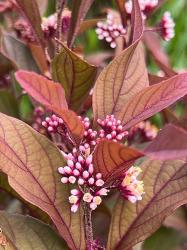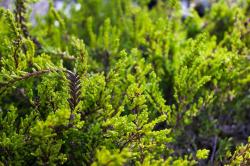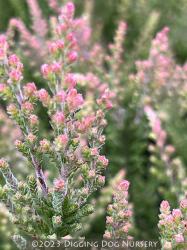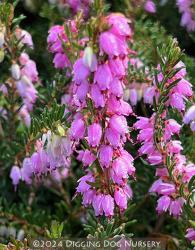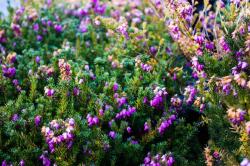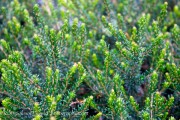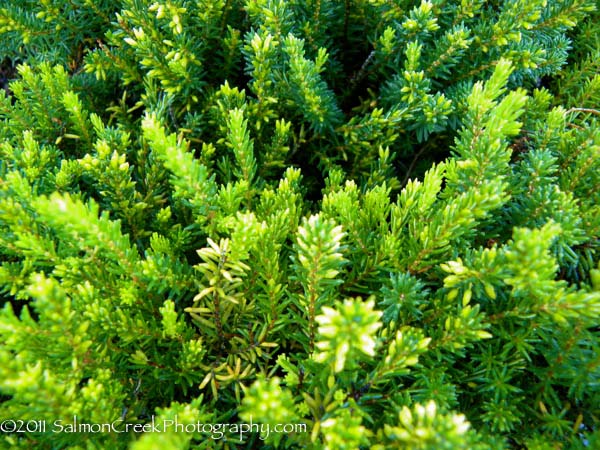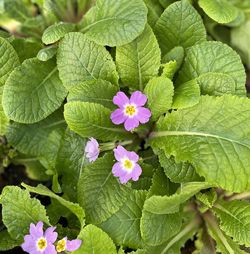Includes Arctostaphylos, Buddleia, Calluna (Heather), Erica (Heath), & Cistus
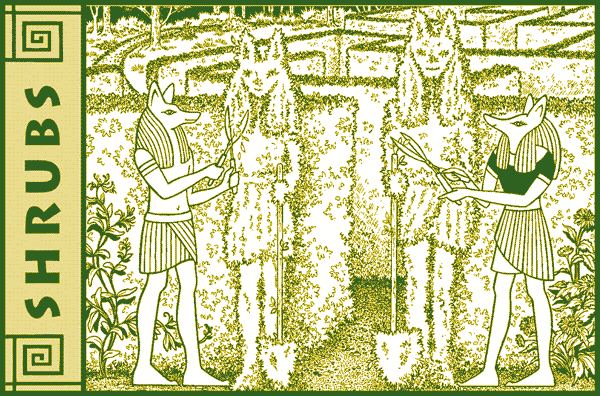
When the joy of gardening with shrubs is discovered, the gardener can begin to think in terms of the future.
Ease of care and permanence are the two great attributes of this plant group, but the prime motivation for planting shrubs is surely their infinite variety of form, which enables them to fulfill a vast range of functions.
The classic concept of gardens as outdoor rooms is based on planting shrubs for garden walls (hedges) and screens. A sense of anticipation and excitement can be created by dividing and defining space with these living barriers, either seasonally with a deciduous selection or year-round with an evergreen.
Developing character with age, shrubs can set the overall tone of a garden, bridging the gap between smaller plants and trees. They can also stand alone as specimens.
Low hedges, clipped or left au naturel, unify the garden by framing beds. Now that we've discussed function, we hope the following descriptions will provide an idea of the varied beauty available and inspire you to plant some of these treasures.
Abelia ‘Edward Goucher’ (S-0873)
Each $15.75
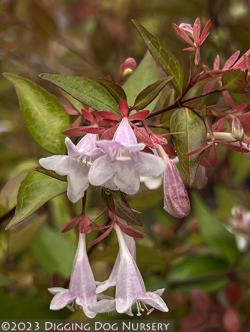
Applauded as a first-class shrub for the smaller garden according to the internationally esteemed Hillier Nursery, this resilient AGM recipient was bred in 1911 by Edward Goucher, a U.S.D.A. employee who masterminded the Abelia x grandiflora and Abelia shumannii cross. Gracefully arching upright branches and shiny ovate dark green leaves cushion a summer-long pollinator-friendly flourish of clustered funnel-shaped lilac-pink flowers with orange-yellow throats plus persistent copper-hued sepals. Remaining evergreen in warmer locales and broadcasting a cozy purplish bronze sheen once fall arrives, ‘Edward Goucher’s compact bushy habit can be sheared into an amenable informal hedge, featured singularly or planted en masse in shrubby borders and along foundations. Good drainage and protection from extreme winter cold sustain its nearly year-round handsome form.
Blooms June–September
Size: 3' 0" – 6' 0" high x 3' 0" – 6' 0" wide.
Zone 6b/7.
OUT OF PRODUCTION AT THIS TIME
Email me when this plant is available
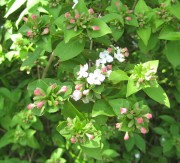
Favored by butterflies and garden visitors alike, masses of pink buds and rose-blushed white trumpet-style blooms, exuding the sweetest most delectable Lilac fragrance, precede colorful long lasting calyxes. Loosely arranged upright arching stems and attractive glossy leaves that glow with spectacular oranges and reds in autumn describe the rounded multistemmed frame. Planted as an easily grown informal hedge or hardy medium-sized specimen, this rarely offered Korean native appreciates periodic pruning and adapts to varied soil types and growing conditions, but detests the heat and humidity of the deep south.
Blooms May–June
Size: 4' 0" – 6' 0" high x 4' 0" – 6' 0" wide.
Hardy to zone 5.
Abutilon
Flowering Maple
A 1993 AGM recipient, this coveted Abutilon is the marvelous progeny of 2 Brazilian species, Abutilon darwinii and Abutilon striatum. Lustrous, 3 in. wide dark maroon floral bells nodding amid large, forest-green foliage are its hallmark. Hummingbirds flock to the nonstop intensely hued blooms with incurved petals and prominent golden stamens, while the upright, somewhat stiff and fast growing, nearly black stems respond well to pruning. Grateful for protection from cold winter nights and scorching afternoon sun, easily cultivated ‘Nabob’ lends tropical-looking drama to a large vessel or garden nook.
Blooms May–November
Size: 7' 0" – 10' 0" high x 4' 0" – 5' 0" wide.
Zone 8b/9.
Abutilon ‘Victor Reiter’ (S-0440)
Each $14.75
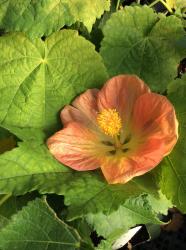
Victor Reiter, the late well-known San Francisco plantsman, is paid homage through the spectacularly large blooms festooning his namesake. Amongst lush maple-shaped dark evergreen foliage, unopened buds, resembling miniature chartreuse pumpkins, give way to tangerine-colored, hibiscus-like flowers held by decorative yellow-green calyxes. The commanding show begs a prominent, even elevated position; stage it under taller trees, against a warm sheltered wall or as a container specimen in cooler climates. Adored by hummingbirds and plant aficionados, this Abutilon’s tailored yet vigorous habit craves well-drained adequately moist soil plus periodic pruning.
Blooms April–November
Size: 8' 0" high x 5' 0" – 6' 0" wide.
Hardy to zone 7.
Agapetes ‘Ludgvan Cross’ (S-0688)
OUT OF PRODUCTION AT THIS TIME
Email me when this plant is available
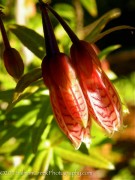
Hailing from the moist forested foothills of the Himalayas, this intriguing Ericaceae family member is a vigorous hybrid between incurvata and serpens that bears lustrous Huckleberry-like foliage. Large woody tubers give way to upright and arching branches neatly lined with red-suffused new growth and slender green leathery leaves.
In an enchanting summertime display, pendulous fairy-tale flowers, each embellished by a tiny maroon checkerboard pattern, resemble narrow, 5-sided creamy white lanterns. Superb as a hanging container specimen or elevated along a pathway amid ferns, ‘Ludgvan Cross’ prefers bright shade, well drained acid soil and a sheltered spot.
Blooms June – August.
Size: 4' 0" high x 4' 0" wide.
Zone 8/9.
Andromeda
Bog Rosemary
Andromeda polifolia ‘Blue Ice’ (S-0796)
Each $13.00
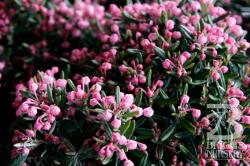
Though the cosmopolitan species roams the northern reaches of North America, Europe and Asia, this hard-to-find intensely colored selection will charm your corner of the world. The astonishing needle-fine, yet tough, frosty blue leaves garb a mounded slow-spreading habit that’s iced with clustered pink buds and delicate white floral urns. Flourishing in cool, moist, somewhat-acidic crannies and pouting in hot humid ones, ‘Blue Ice’ makes a well-groomed evergreen standout for stone work, a low-growing border or a container.
Blooms March–April
Size: 18" high x 2' 0" wide.
Hardy to zone 2.
Arctostaphylos
Manzanita/Bearberry
Sinuous and smooth, earthy red-tinged branches, waxy urn-style blossoms and tasteful rounded evergreen leaves—that’s Manzanita. An enormous clan mostly indigenous to the far western U.S., these easily cultivated durable woody plants call for excellent drainage, but can endure poor soil, thriving in rocky, sandy or acidic sites with minimal water. Light afternoon shade and occasional watering are appreciated in hotter locales.
Arctostaphylos edmundsii ‘Carmel Sur’ (S-0131)
Each $14.75
This natty tightset ground cover hosts dainty urn-shaped white flowers amid small lustrous gray-green leaves that burst forth with cozy bronze hues. A low, fast spreading evergreen gem introduced by Saratoga Horticultural Foundation in 1972, ‘Carmel Sur’ takes on heat, heavy clay soil, dry conditions and regular summer irrigation, better than most Manzanitas. It smothers weeds, stabilizes slopes and serves as a verdant lawn replacement.
Blooms March–April
Size: 12" high x 4' 0" – 6' 0" wide.
Hardy to zone 8.
Full of vigor and bright, fine textured greenery, this coastal California native spreads to form a low, handsome mound. Rubescent brown branches gracefully sweep upwards and sometimes grow in twisted shapes, forming a framework for the upfacing, pointed leaves, reddened stems and dainty white flowers.
Always appreciative of well drained sites, and when grown inland, summertime watering with a little shade, ‘Wayside’ is a superb candidate for banks, rock gardens or native plantings accompanying Erigeron ‘Ron’s Pink’ and Deschampsia ‘Goldgehänge’.
Blooms February–April
Size: 2' 0" – 3' 0" high x 6' 0" – 8' 0" wide.
Hardy to zone 8.
Flat-growing reddish brown branchlets with gleaming miniature dark greenery, an unmatched profusion of flowers and berries plus superb disease resistance set ‘Little Leaf Massachusetts’ apart. Exhibiting exceptional cold tolerance and perhaps the tiniest, spot-free leaves of all uva-ursi species, this wildly popular prostrate ground cover turns burgundy when cold weather arrives, cascades down banks or over walls and thrives in poor, acidic sandy soil.
Blooms April–May
Size: 6" – 12" high x 3' 0" – 4' 0" wide.
Zone 2b.
Arctostaphylos uva-ursi ‘Radiant’ (S-0668)
Each $14.75
Lustrous, trim and fresh looking, this prostrate evergreen ground cover keeps its composure all year long. Small, rich green leathery leaves glow with wintertime reddish purple tinges, while ushering in quantities of light pink urn-like flowers, followed by showy red apple-shaped berries that birds adore. A sturdy northern California native reputed to possess astringent qualities, ‘Radiant’s lush close-to-the-ground mat brings verdant low maintenance accents to a native or Mediterranean setting.
Blooms March–April
Size: 6" – 8" high x 3' 0" – 5' 0" wide.
Hardy to zone 5.
A tidy low growing mainstay for the rockery, the oblong and narrow, vivid deep green leaves and red-tinged petioles clasp long slender stems to create a closely knit, polished ground cover. Aptly named ‘Vancouver Jade’ premiers pale pink flowers in early spring, broadcasts reddish bronze tones in winter and boasts a vigorous disease-resistant habit.
Blooms March–April
Size: 6" high x 3' 0" & spreading wide.
Hardy to zone 5.
Aronia
Chokeberry
Aronia melanocarpa ‘Iroquois Beauty’ (S-0600)
OUT OF PRODUCTION AT THIS TIME
Email me when this plant is available
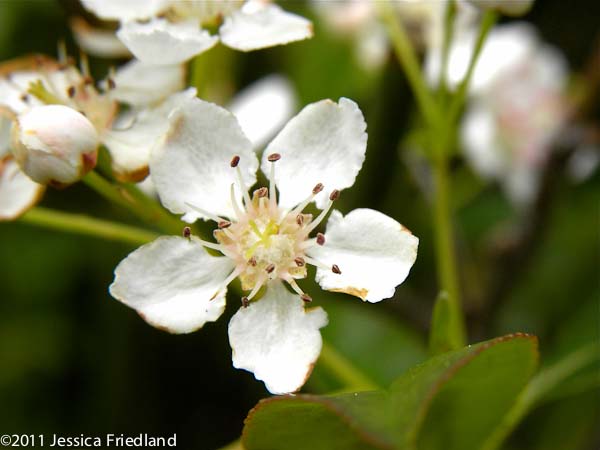
A versatile North American native originating in Morton Arboretum, this small-statured deciduous shrub proposes something exceptional for each season: fragrant spring flowers, courtly summer foliage, brilliant fall color and persistent winter berries. Flaunting an autumnal pageant of stunning red, burgundy and purple hues, lustrous, deeply green, thickened leaves garb the compact, dense multitude of suckering stems. Airy, Hawthorne-like flowers gathered in white, 2 in. wide, eye catching corymbs precede the heavy clusters of polished purple-black berries that gracefully weigh down branches and bring color to gray December days.
Obliging of low-lying wet areas, dry sandy sites and some shade, easy-to-grow ‘Iroquois Beauty’ thrives in full sun and can reside with equal ease in a small garden, a mixed border or a naturalized setting when planted en masse.
Blooms April–May.
Size: 3' 0" high x 3' 0" wide.
Hardy to zone 3.
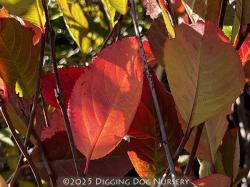
Deemed one of the best cultivars in the genus, this small trouble-free European introduction was destined to be a orchard plant until gardeners discovered its innate beauty and various merits. Glimmering amid glossy dark green foliage, abundant scented white flowers are followed by lustrous extralarge purplish black berries, which make tasty nutritious additions to pies and jellies, and remain throughout the winter as fodder for the birds, especially early spring-feeding robins. ‘Viking’s pleasing deciduous profile blazes with vivid red autumn leaves and seldom needs pruning, plus it withstands drought and most pests.
Blooms April–May
Size: 3' 0" – 5' 0" high x 3' 0" – 5' 0" wide.
Hardy to zone 3.
Each $16.25
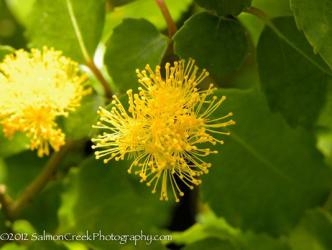
The shiny evergreen leaves are toothed, as the name implies, but that is hardly their most interesting feature. This handsome Chilean native bears paired dark green leaflets plus a unique shingle-like layer of tiny round leaves. Growing in a graceful somewhat open manner, extended arching branches host bountiful golden yellow blooms—clustered, fluffy, round starbursts—which exude a sweet fragrance, delighting all garden visitors, especially butterflies and hummingbirds. Exemplary as a verdant backdrop, screen or informal hedge, fast growing A. dentata tolerates redwood roots, responds well to pruning, relishes adequate drainage and requires protection from hot afternoon sun and cold winds.
Blooms March–May
Size: 10' 0" – 16' 0" high x 8' 0" wide.
Hardy to zone 8.
Azara microphylla ‘Variegata’ (S-0624)
Each $17.75
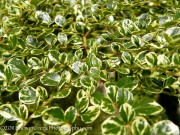
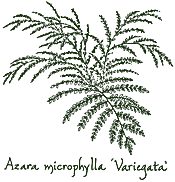
While the species hails from Chile, Azara ‘Variegata’ originated in Ireland and everything about this evergreen shrub is elegant. Its dainty dark green gleaming leaves are rimmed by broad alabaster margins as they cloak sprays of graceful downward-arching branches. Achieving a unique herringbone look, the diminutive leaflets feature smaller, overlapping leaves at their bases and in early spring, tufted flowers laden with the heavenly sweet whiff of vanilla. Slowly growing into a large specimen that emphasizes sophisticated texture and pattern, especially when superimposed against a wall, it begs a sheltered west or south facing site, sulks in hotter climates and can easily be pruned to fit just about any other garden spot.
Blooms March–April
Size: 13' 0" high x 9' 0" wide.
Hardy to zone 8.
Berberis
Barberry
A genus of hundreds of species of shrubs, found throughout the temperate and subtropical regions of the world (apart from Australia). Our selections are Black Barberries, Berberis thunbergii.
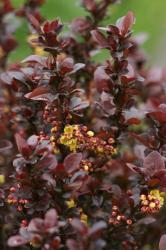
Draped in deep maroon velvety purple foliage, this splendid diminutive shrub maintains a dense rounded slow growing profile. Small bell-shaped yellow flowers, enhanced by warmly colored sepals, sparkle against opulent deciduous leaves, eventually giving way to a wintertime showing of bright red berries. Perfectly sized for edging, responsive to pruning and unyielding to deer or drought, ‘Concorde’ is a refined and easily maintained contender for containers, border frontage, low hedges and knot gardens, especially when paired with silver and green companions.
Blooms March–April.
Size: 18" – 2' 0" high x 18" – 2-1/2' wide.
Hardy to zone 4.
Berberis thunbergii f. atropurpurea ‘Helmond Pillar’ (S-0782)
OUT OF PRODUCTION AT THIS TIME
Email me when this plant is available
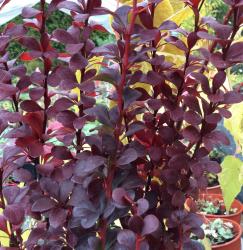
Imprinting a remarkable architectural aspect upon the landscape, this adaptable cultivar sculpts bold upright columns of rounded deep reddish purple leaves, which transmute brilliant red fall color. Multiple staunch ruddy brown stems sport richly colored deciduous foliage, plus clustered small yellow flowers followed by shiny bright red persistent berries. Utilized as a first-rate hedge or small screen, ‘Helmond Pillar’ is equally at home in an urban setting or a country garden, where it can frame a vista or entrance way, or stand sentinel in the mixed border.
Blooms April–May
Size: 4' 0" – 5' 0" high x 12" – 2' 0" wide.
Hardy to zone 4.
Buddleja
Butterfly Bush
Around midsummer, when the pendulous racemes of flowers weigh down its boughs, it’s hard to decide which is more satisfying: Buddleja’s abundant, often fragrant blossoms, or the myriad butterflies they attract.
Each $13.75
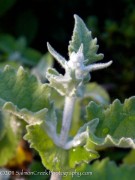
One of the softest looking plants in our garden, this exceptional Himalayan native invites a touch every time we stroll by. Displaying white wooly undersides and toothed, wavy-edged margins, the 6 in. long, broadly shaped gray-green leaves are oh so fuzzy! In summer, stout felted branches host densely set lilac panicles of fragrant, orange-throated flowers. With its downy silver visage, Buddleja crispa makes a luminous partner for Phlox ‘David’ in the mixed border.
Blooms July–October.
Size: 4' 0" – 5' 0" high x 4' 0" – 5' 0" wide.
Hardy to zone 6.
Buddleja davidii ‘Summer Beauty’ (S-0584)
Each $13.75
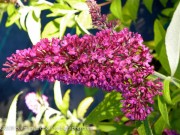
‘Summer Beauty’ is our favorite pink blooming Butterfly Bush. Headlining large, conical and richly rosy, fragrant trusses that make gorgeous cut flowers, and a tidy, fast growing, yet compact stature of gently curving branches, this Buddleia makes an excellent small specimen.
The handsome pewter-tinged leaves can be blended with the like-hued foliage of Salvia clevelandii. ‘Aromas’ and Lavenders for a restful, silvery garden vista. Include Euphorbia ‘Dean’s Hybrid’s acid-yellow blooms for a more exuberant summer display.
Blooms June–early October.
Size: 6' 0" – 7' 0" high x 4' 0" – 5' 0" wide.
Hardy to zone 5.
Buddleja davidii ‘White Profusion’ (S-0709)
Each $13.75
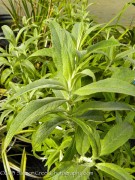
A classy mainstay for the border that entices hummingbirds, butterflies and beneficial insects as well as two-legged garden visitors, ‘White Profusion’ lives up to its name. This fast growing ultrahardy shrub spotlights silver-backed green leaves beneath a sparkling blanket of huge, arching snowy white clusters crowded with fragrant yellow-eyed flowers. Deadheading will keep the brilliant blooms coming all summer long, while a hard spring pruning will help maintain a smaller, more manageable size.
Blooms June – August.
Size: 8' 0" high x 5' 10" – 7' 0" wide.
Hardy to zone 5.
Buddleja ‘Ellen’s Blue’ (S-0670)
Each $13.75
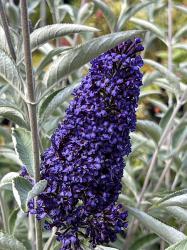
Copious, deeply blue trusses and a shorter compact carriage earned this stellar new Butterfly Bush a tie for first place at Longwood Garden’s Buddleja trials. Originally springing up as a chance ‘Lochinch’ seedling in Ellen Hornig’s New York garden and later introduced by Heronswood Nursery, ‘Ellen’s Blue’s gray-green foliage and light stems shape a relatively small versatile shrub that is easier to slip into your garden than her more hefty cousins. Good-sized and opulent with a sweet fruity aroma, the floriferous performance lulls zesty summertime shades like the orange torches of Kniphofia ‘Bee’s Sunset’.
Blooms June–early October
Size: 4' 0" – 5' 0" high x 4' 0" – 5' 0" wide.
Hardy to zone 5.
Each $13.75
This uncommon South African Buddleja soothes the garden with a composed evergreen appearance. Offsetting the darker green-gray leaf tops, a downy white felt envelops the new growth, foliar undersides and arching stems. Tiny teeth and a bumpy texture define the long narrow, leatherlike foliage that’s reminiscent of willow leaves, while lavender flowers borne in short racemes embellish them.
Stage amid Molinia ‘Bergfreund’ and Sedum ‘Indian Chief’ for contrasting forms and color.
Blooms July–August.
Size: 6' 0" high x 6' 0" wide.
Hardy to zone 8.
Buddleja x ‘Lochinch’ (S-0005)
Each $13.75
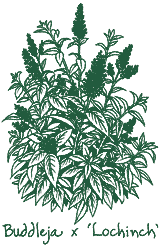
A descendant of two Chinense species, Buddleja davidii and Buddleja fallowiana, this unrivaled old favorite inherited its parents’ most stellar qualities–large fragrant blooms, white felted stems and a graceful yet robust stature. Deep orange eyes sizzle amid 8 in. long branched panicles of tightset violet-blue flowers. Blanketed in white wool, the stems and new leaves make a cozy counterpoint to the smooth green topsides of older deciduous foliage, which retains frosted fuzzy undersides.
Maturing into an imposing bushy shrub, ‘Lochinch’ can be surrounded by ribbons of ornamental grasses for contrasting shapes and colors, or be under-planted with Stachys ‘Silver Carpet’ for a soft textural echo.
Blooms July–October.
Size: 8' 0" – 9' 0" high x 6' 0" – 7' 0" wide.
Zone 7/8.
Buddleja x pikei ‘Hever’ (S-0648)
OUT OF PRODUCTION AT THIS TIME
Email me when this plant is available
Originating at England’s Hever Castle, this fine textured Buddleja is graceful and early to bloom. The gray-green deciduous foliage is small and fuzzy, oblong-shaped and silver on the flip side, inheriting the good looks of its Buddleja alternifolia parent. Laden with dense fragrant sprays that showcase orange-throated mauve flowers, the fast growing arched stems die back in colder climates and can be maintained by a hard pruning just after the first frost in warmer areas.
Blooms July–August.
Size: 7' 10" high x 6' 0" wide.
Zone 6/7.
Buddleja x weyeriana ‘Bicolor’ (S-0740)
Each $13.75
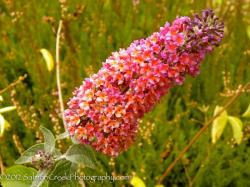
Hats off to esteemed horticulturist Michael Dirr for this unprecedented breakthrough hybrid with 8 to 10 in. long trusses simultaneously featuring two completely different hues. ‘Bicolor’s happy-looking colorful fusion, includes lavender buds and peachy pink blooms, which attain a canary yellow cast as they mature. Amid a compact, easily managed profile clothed in soft gray-green leaves, the fragrant spectacle arrives during the dog days of summer, luring butterflies and appearing particularly upbeat when matched with Panicum ‘Cloud Nine’ and Lavandula ‘Violet Intrigue’.
Blooms July – early October.
Size: 6' 0" – 8' 0" high x 6' 0" – 8' 0" wide.
Hardy to zone 5.
Buddleja x weyeriana ‘Honeycomb’ (S-0558)
Each $13.75
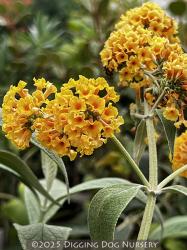
Unique for its breathtaking sweetly scented spectacle of glorious clear-yellow blossoms warmed by orange eyes, this Mike Dirr cross between davidii and globosa is deemed the best of the yellow-blooming Buddleja. A winsome, somewhat close-knit silver-laced foundation unleashes globe-shaped, 4 to 6 in. long terminal panicles, welcoming plant mavens, florists and butterflies, while adding ebullient long-lasting summer accents to mixed border companions such as Persicaria ‘Blackfield’ and Salvia ‘Limelight’.
Blooms mid-June–October
Size: 5' 0" – 7' 0" high x 4' 0" – 5' 0" wide.
Hardy to zone 5.
Each $14.25
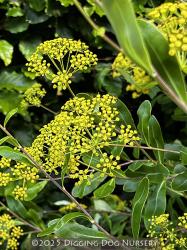
Imbued with soft soothing hues, a dense, round and shapely hummock hosts narrow, leathery sea green foliage that’s lustrous, oval-shaped and dons gray undersides. Tiny sulphur yellow flowers swirling in neat, airy umbels stage a light-hearted dance upon this medium-sized evergreen shrub for most of the summer and early fall.
Whether positioned as a specimen, massed as a screen or windbreak or utilized as a backdrop for a mixed planting, its quiet, yet handsome persona is sure to please.Though this Mediterranean dweller may need some winter protection, it easily endures tough dry sites and exposed coastal conditions.
Blooms July – October
Size: 6' 0" high x 6' 0" wide.
Zone 6/7.
Buxus
Boxwood
Each $12.25
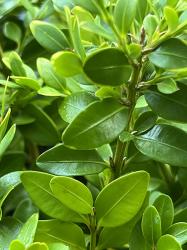
Adaptability, resilience and verdurous beauty set this topnotch cultivar apart. Selected by the esteemed Chicago Botanic Garden-based breeding program, ‘Glencoe’s dashing dense rounded habit quickly develops into a semidwarf evergreen shrub. Promoting impressive cold hardiness and a English Boxwood likeness, the fine textured dark green leaves can be sculpted into natty hedges, pruned in a more casual manner and juxtaposed against bold-leafed Persicarias.
Size: 2' 0" – 3-1/2' high x 2' 0" – 3-1/2' wide.
Hardy to zone 4.
Each $12.25
Developed at Ontario’s Sheridan Nursery, this handsome open-pollinated cross between Buxus sempervirens and Buxus microphylla var. koreana is a match made in heaven that melds the best traits of both parents: diminutive compact size, superb cold hardiness, dense vigorous growth and rich forest-green winter hues. The tightknit, naturally broad mounding habit is neatly dressed with small, gleaming opposite leaves. Undaunted by deer, shearing and hot humid weather, aptly named ‘Green Velvet’ makes a low edging shrub, posh container specimen and a classic dark green addition to borders, parterres, knot gardens and massed plantings. Mulch, good drainage, dappled afternoon shade in hot environs plus an annual thinning for improved air circulation promise long-lived evergreen growth.
Size: 3' 0" – 4' 0" high x 3' 0" – 4' 0" wide.
Hardy to zone 5.
Hallmarked by a well groomed verdure, the low growing ‘Green Beauty’ is second-to-none for hedging or edging, accenting the rock garden or making an architectural statement just about anywhere. Polished, small rounded leaves maintain a crisp, dark green look all year long while cloaking the upright, yet compact semidwarf form.
This versatile evergreen can handle hot and cold weather and makes a plucky counterpoint amid Westringia ‘Smokey’ or Teucrium fruticans (Select Form).
Size: 4' 0" – 6' 0" high x 4' 0" wide.
Hardy to zone 6.
Applauded as one of the species’ premier forms, this good-looking chance mutation of Buxus sempervirens ‘Suffruticosa’ was discovered by its namesake in Germany’s Herrenhausen Royal Garden in the late 1980s. Hardier than other sempervirens, the distinctive dwarf habit assumes a rounded, strictly upright and compact shape with densely set small shiny evergreen leaves, sporting unique frosted blue-green hues. A dapper first-class choice for low borders, diminutive hedges, rock work and pots, ‘Blauer Heinz’ favors adequately moist, well-drained soil and requires little pruning or maintenance.
Size: 2-1/2' high x 2-1/2' wide.
Hardy to zone 5.
Buxus sempervirens ‘Graham Blandy’ (S-0834)
Each $12.25
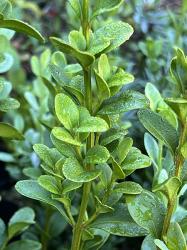
Introduced in 1949 by the University of Virginia’s Blandy Experimental Farm, this aristocratic evergreen Boxwood struts a suave, strongly upright narrow stance. Dense erect branches are clothed from the ground up with small, polished oval leaves that emphasize new springtime, soft green growth and once mature, rich dark emerald tones. A topnotch choice for any garden, especially where space is limited, ‘Graham Blandy’s impeccable columnar habit can be employed as a specimen, or as a sentinel to denote a threshold, or it can be staged throughout a stylized meadow.
Size: 6' 0" – 9' 0" high x 18" – 2' 0" wide.
Hardy to zone 5.
Buxus sempervirens ‘Vadar Valley’ (S-0710)
OUT OF PRODUCTION AT THIS TIME
Email me when this plant is available
This handsome Boxwood is distinguished by a lustrous mass of tiny dark green leathery leaves, maintaining superb winter color then transmuting a pronounced bluish cast in spring, while dressing a hardy, broad spreading habit. ‘Vadar Valley’ thrives with sun or shade, stays fairly short and rounded, grows at a moderate pace, and is the perfect choice for foundation plantings, low hedges or grouped statements, anywhere its emerald hues can shine.
Size: 2-1/2' high x 5' 0" wide.
Hardy to zone 5.
Buxus sinica var. insularis var. insularis (S-0669)
OUT OF PRODUCTION AT THIS TIME
Email me when this plant is available
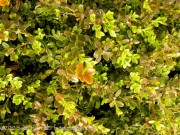
With a tailored demeanor clipped or not, this undemanding Boxwood is second-to-none for hedging, edging, accenting the rockery or sculpting a topiary or bonsai specimen. Young downy branches and lustrous, small elliptical leaves in crisp dark greens define the dwarf rounded form that grows slowly and a little less densely.
A reliably cold tolerant evergreen, it can be planted as a low and refined verdant border, allowing more rambunctious plants to exuberantly spill over.
Size: 2' 0" high x 20" wide.
Hardy to zone 4.
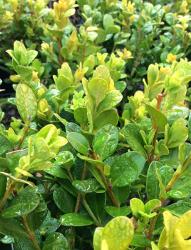
Introduced in 1960 by Ohio’s Scarff Nursery, this robust broad-leafed evergreen proclaims improved pest resistance and superb cold-hardiness plus a tasteful medium green coloration that’s less likely to bronze during the winter. Bearing sparse, scented, tiny chartreuse blooms in spring, numerous densely woven branches coupled with trim, petite ovate leaves forge a compact, slow growing mounded form. ‘Wintergreen’ injects a pleasing air of refinement to massed plantings, formal hedges, mixed borders, containers and even bonsai collections.
Blooms April–May
Size: 4' 0" – 5' 0" high x 4' 0" – 5' 0" wide.
Hardy to zone 4.
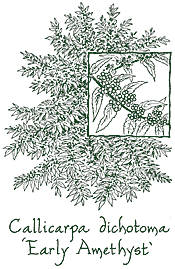
A beacon for the fall border, this deciduous Korean species is considered by many to be the most courtly Beautyberry available, plus its boldly hued early September fruit occurs before other varieties. Small and shiny, rounded berry clusters achieve an astonishing, almost electric lavender hue. Flowers are delicate, diminutive and pink, quietly dressing up its handsome, very green leaf mass and gracefully rounded form. ‘Early Amethyst’ enjoys well-drained soil, tolerates some drought, favors a late winter pruning and produces more fruit when planted in groups.
Blooms August
Size: 3' 0" – 4' 0" high x 3' 0" – 4' 0" wide.
Hardy to zone 5.
Callicarpa x ‘Pearl Glam®’ (S-0886)
Each $15.75
Heaths and Heathers
Heaths (Erica) and Heathers (Calluna) are best en masse. Drifts of their varied forms and flower and foliage colors blend beautifully. They're also fine companions for Rhododendrons, Azaleas, Pieris and other acid-loving plants in the evergreen shrubbery. The timid might try adding a few winter bloomers to the herb or perennial border for year-round interest… but be forewarned—to plant one is to want them all!
Requiring good drainage and poor, acidic soil, the Heaths and Heathers are ideal for the coastal garden. Some will perform well inland, preferring light shade, but they're sensitive to extremes of heat and cold. Wind and salt spray are tolerated as long as the plants are away from the front lines. Prune annually, with a shearing after the blooms are spent.
Calluna
Heather
Callunas’ tiny scale-like leaves range from deep green to silver, gold and bronze, with some changing color after a frost. Flowering from mid-to-late summer in cool whites, pinks and purples, the small bell-shaped flowers are frozen in graceful repose on one-sided spikes. Heathers are marvelous, fresh or dried.
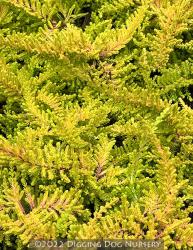
Once you witness the blazing intensity of this bushy mat-forming beauty there’s no disputing its name. Summer paints sun-kissed gold and orange shades on dense needle-shaped foliage bejeweled with late blooming soft lavender-colored flowers, while frosty nights imbue radiant dark crimson reds to heat up the coldest winter day. ‘Blazeaway’ can be massed near Calluna vulgaris ‘Firefly’ and Calluna vulgaris ‘Wickwar Flame’ and juxtaposed against the dark greenery of Erica cinerea ‘Purple Beauty’ for a fulgent quilt-like spectacle.
Blooms August–September
Size: 12" high x 15" – 18" wide.
Hardy to zone 4.
Calluna vulgaris ‘Bonita’ (S-0788)
OUT OF PRODUCTION AT THIS TIME
Email me when this plant is available
This relatively new small-sized Heather makes a prismatic four season statement. Known as a ‘bud bloomer’ producing copious plump buds that don’t actually open, ‘Bonita’s snug tidy hummock signals late summer with gorgeous long-lasting reddish magenta buds. Stunning saffron, burnt orange and old gold shades enliven the fine-textured foliage and when cold weather arrives bronze tones provide additional cozy accents.
Blooms August–September
Size: 12" – 18" high x 18" – 2' 0" wide.
Hardy to zone 4.
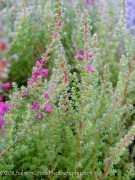
Named for the Oregon nursery where it originated, this reliable American cultivar offers striking crimson flowers that nearly obscure its low mound of handsome greenery. ‘Corbett’s Red’ is a compact, spreading Heather whose richly hued blooms can be partnered with Spiraea ‘Ogon’.
Blooms August–September
Size: 12" high x 2' 0" wide.
Hardy to zone 4.
Calluna vulgaris ‘Dark Beauty’ (S-0654)
Each $12.00
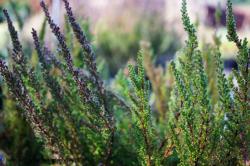
With full bodied colors similar to a fine Pinot Noir, this enticing beauty queen flaunts the darkest hued flower of all Callunas. Deep red buds reveal showy and plentiful, semidouble dark cherry blooms that shade to ruby amid a good-looking, compact forest-green silhouette. Earning Holland’s prestigious Gold Medal award, ‘Dark Beauty’ will beckon you to her side whether she’s poised in the rockery, along a pathway or in a container.
Blooms August–October
Size: 8" – 10" high x 14" – 16" wide.
Hardy to zone 4.
Calluna vulgaris ‘Firefly’ (S-0653)
Each $12.00
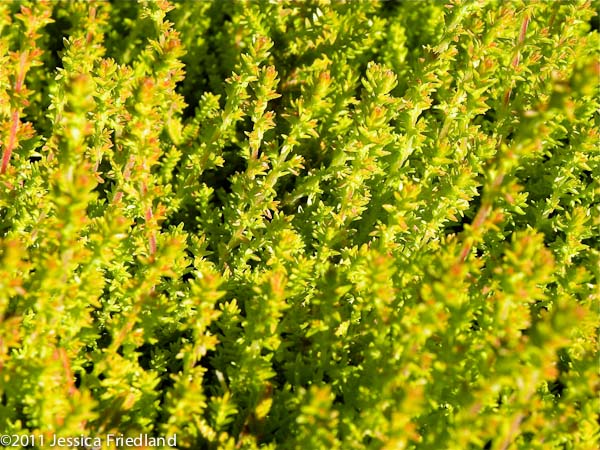
Celebrating some of the most vibrant brick-red foliage among the species, ‘Firefly’ never fails to snap us out of a gray winter-day funk. Sensational warm shades ranging from salmon to terracotta suffuse the leaves the rest of the year, while deep mauve flowers spangle its dense upright frame in late summer. A champion of Britain’s sought-after AGM, this vividly colored Heather merits a choice niche in your garden.
Blooms August–September
Size: 18" high x 20" wide.
Hardy to zone 4.
Calluna vulgaris ‘Flamingo’ (S-0437)
Each $12.00
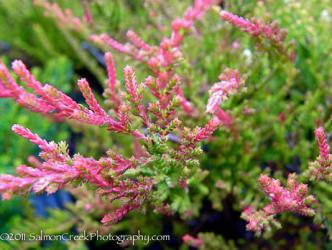
Welcoming spring, young growing tips dress up with striking pink and fiery red hues that look resplendent against the more mature dark green foliage. Lavender-colored flowers make a late summer appearance and extend this upright cultivar’s lively display of color.
Blooms August–September
Size: 12" high x 20" wide.
Hardy to zone 4.
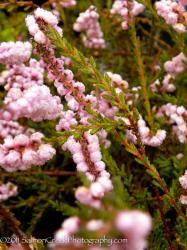
Named for the owner of the former British nursery Maxwell & Beale, this shapely AGM recipient has graced gardens since 1925 and remains nearly everyone’s favorite Calluna. Small linear gray-green leaves clothe a compact dense-growing habit that promotes upright spiky racemes of lovely shell-pink double flowers. Emphasizing soft hues, ‘H. E. Beale’s profuse long-lasting pastel blooms blend with summertime color schemes, and in winter the mauve-infused evergreen foliage further extends the soothing tones.
Blooms July–September
Size: 18" high x 2' 0" wide.
Hardy to zone 4.
Without a doubt, this AGM winner plays host to the most lovely double white flowers in the genus. Slowly opening, tiny buds reveal long, downward curving frosty blooms, illuminating the fine textured, bright green foliage that possesses a mounding habit, and in winter, bronze dipped tips.
Blooms July – August
Size: 16" high x 2' 0" wide.
Hardy to zone 4.
With a nod to its name, this tailored low spreading Calluna serves up scarlet spring growth, then gilt, copper and lime laden leaves for the warmer months along with tiny pale mauve late summer flowers. Lucent colors announce winter in orange and red shades, easily igniting a bleak chilly day. Rarely offered and slow growing, ‘Multicolor’ can be planted alongside dark green evergreen companions, tucked amid rocks or massed atop a wall.
Blooms August–September
Size: 6" high x 12" – 15" wide.
Hardy to zone 4.
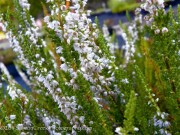
Offering a clean and classic look in the garden, this Calluna’s frosty-white spires make prized additions to fresh or dried arrangements. Later to flower than most Heathers, the elegant fall blooms are showcased against attractive deep green foliage on upright branches. For varied forms, its pert stance can be coupled with Acaena saccaticupula’s low-lying, silvery-blue leaves.
Blooms September–October
Size: 16" high x 18" wide.
Hardy to zone 4.
Calluna vulgaris ‘Red Star’ (S-0769)
Each $12.00
Distinctive for its opulent finery, 'Red Star' flashes deep purplish red double blooms on long upright flower spikes near summer's end, earning this attractive somewhat open growing Calluna its name. Tiny dapper leaves craft a dark forest green foil that offsets the vivid blossoms and counterposes lime and golden-leafed Heathers, such as Calluna vulgaris 'Blazeaway' to great effect.
Blooms August–September
Size: 12" – 18" high x 18" – 2' 0" wide.
Hardy to zone 4.
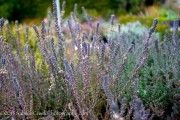
Heralding handsome woolly gray foliage throughout the year, this knightly cultivar is yet another J. W. Sparkes introduction. Colder weather paints violet tinges on the leaves, while late summer finds upright branches studded with purple flowers near the tips. Plant ‘Silver Knight’ alongside deep green companions such as Calluna vulgaris ‘Dark Beauty’ and Erica ‘Rackliff’ and a captivating contrast is yours to enjoy.
Blooms August–September
Size: 20" high x 2' 0" wide.
Hardy to zone 4.
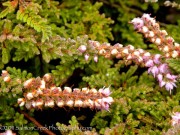
Bursting with lush growth in spring, ‘Sister Anne’s gray-green foliage makes a composed backdrop for her dainty light pink flowers. Cold weather adds a hint of purple to the dense low-mounding form that can be ensconced along pathways or tucked into rocky nooks.
Blooms July–September
Size: 6" high x 18" wide.
Hardy to zone 4.
Calluna vulgaris ‘Spring Torch’ (S-0013)
Each $12.00
Way back in 1938, Miss Isabel Young, who was nicknamed Tib, happened upon this exceptional Heather in Scotland’s Pentland Hills. Unparalleled as a cut flower, either fresh or dried, the splendid rosy-crimson double blooms, borne on long, erect slender stems, festoon a compact bushy mound of fine textured dark green foliage. Eventually claiming a coveted AGM, ‘Tib’ has withstood the test of time and promises to be a champion in your garden, especially when set against the varied foliage of other Callunas such as Calluna ‘Firefly’ and Calluna ‘Sister Anne’.
Blooms July–September
Size: 18" – 2' 0" high x 2' 0" – 2-1/2' wide.
Hardy to zone 4.
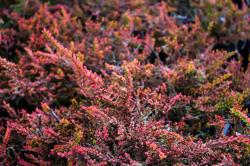
With so many upright and horizontal stems, this Heather has an especially wild appearance in its youth. When it matures, however, it develops into a dense, tight mound of unusual foliage: burnt orange-yellow on the upper half and lime-green below, where it is protected from the sun.
During the winter months the color intensifies, making the shrub appear almost as though it’s on fire. During the summer, the color spectrum is extended with lavender- pink flowers blooming along the upper portion of the stems.
Blooms late July–August
Size: 15" high x 2-1/2' wide.
Hardy to zone 4.
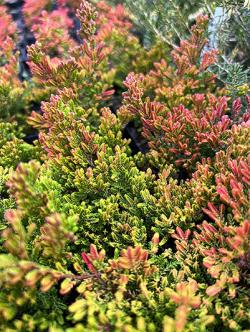
A delightful melding of warm colors, ‘Winter Chocolate’ is a year-round marvel in our Heather garden. Radiantly bedecked with chartreuse, chocolate and golden hues for winter, spring’s new growth brings creamy salmon-red tips. As the days grow longer, the foliar shades broaden to an alluring range of orange, pink and yellow, toned by bright green. As if this isn’t enough, soft lavender blossoms just about engulf the plant in late summer.
Blooms August–October
Size: 12" – 20" high x 18" – 2' 0" wide.
Hardy to zone 4.
Erica
Heath
Heaths have fine, short, needle-like evergreen leaves that vary from deep green to silver, gold, or chartreuse. Tiny urn-shaped flowers sparkle like hoarfrost in shades from white to pink and rosy purple. Though most floriferous in winter and early spring, (and highly welcome at that dreary time!), a scheme for year-round color can be developed by combining Ericas with Callunas.
A beacon of dazzling color, the low-to-the-ground mat is cloaked in distinctive needlelike foliage set aglow with gilded yellow hues and bronzy red tips. Resulting as a sport from ‘Vivellii’ and named by J. W. Sparkes in 1955 for his sister-in-law, this lambent beauty is further heightened when her carmine-red racemes unfurl, cheering up a drab winter landscape.
Blooms February – March
Size: 6" – 9" high x 12" – 15" wide.
Hardy to zone 4.
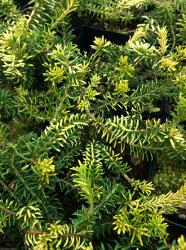
This shining starlet guarantees a year-round performance. Bred by Germany’s Kurt Kramer, ‘Golden Starlet’ is favored for its bright golden foliage, snowy white blooms and tidy, low spreading habit. During the summer months, the leaves attain a glowing yellow hue, while cooler weather brings lime-green accents and splendid flowers that last all winter.
Blooms December–March
Size: 6" high x 16" wide.
Hardy to zone 5.
Erica carnea ‘King George’ (S-0214)
OUT OF PRODUCTION AT THIS TIME
Email me when this plant is available
Deemed one of the loveliest and most decorative Heaths, this highly touted Erica displays bright rosy red flowers on a tidy, compact mound of Yew green foliage. Be sure to reserve a prominent spot for ‘King George’s abundant blooms, so you can easily relish them during winters’ gray days.
Blooms December–March
Size: 6" – 9" high x 18" – 2' 0" wide.
Hardy to zone 5.
Erica carnea ‘Myretoun Ruby’ (S-0175)
Each $12.00
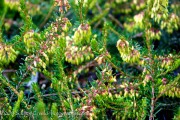
Donning the name of a castle in Wigton, Scotland, ‘Myretoun Ruby’s low-spreading forest-green needles and deep reddish purple blooms achieve a gem-like richness. Perhaps the darkest red flowering carnea in cultivation, this Erica’s saturated blossoms age with bright crimson highlights. Nestle beside Ajuga ‘Chocolate Chip’, and relish the cold weather splendor.
Blooms December–March
Size: 10" – 12" high x 2' 0" wide.
Hardy to zone 5.
Erica carnea ‘Pink Spangles’ (S-0213)
Each $12.00
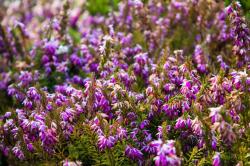
Distinguished by large two-toned blooms and a robust yet gracious form, ‘Pink Spangles’ paints the winter garden with a truly dynamic floral display. Winsome medium green foliage comprises the superb low spreading ground cover, while myriad lime-colored buds introduce pretty shell-pink sepals and rosier pink petals.
Blooms January–March
Size: 9" – 12" high x 2' 0" wide.
Hardy to zone 5.
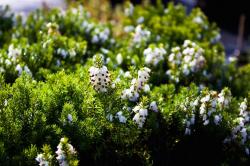
The result of some meticulous Erica ‘Snow Queen’ and Erica ‘Springwood White’ hybridizing by legendary plantsman Kurt Kramer, this compact much improved cultivar is near the top of many plant lover’s favorite Erica list. German for snow peak, ‘Schneekuppe’ commands its name when a long lasting avalanche of urn-shaped pure white flowers tumbles over low well-groomed bright green foliage. Tailor-made for tight spots, the rockery or drifts, its hardy easy-care foundation imparts illuminated floral accents during the winter months plus cream-colored new foliar growth as a spring bonus.
Blooms January–March
Size: 6" high x 12" – 15" wide.
Hardy to zone 5.
Erica carnea ‘Springwood Pink’ (S-0015)
Each $12.00
Erica carnea ‘Springwood White’ (S-0016)
Each $12.00
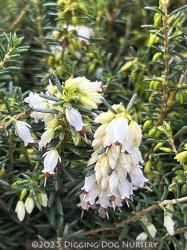
Delighting gardeners since 1930, this all-time favorite hosts creamy buds and white flowers. ‘Springwood White’ forms a robust fast growing ground cover that handles inland heat and tough conditions. Calluna ‘Martha Herman’ is its best mate.
Blooms October–January
Size: 10" high x 2' 0" wide.
Hardy to zone 5.
Erica cinerea ‘C. D. Eason’ (S-0565)
Each $12.00
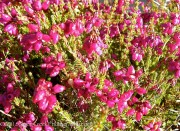
Distinctive for its deep green, fine textured foliage and pleasing appearance, this summer blooming Erica was named in honor of the man who discovered it—Australian born Charles Eason. Very tiny short needles and slender branches make an ideal foil for the freely borne, dense clusters of glowing dark pink flowers.
Blooms June – September
Size: 12" high x 15" – 20" wide.
Hardy to zone 5.
Erica cinerea ‘Purple Beauty’ (S-0471)
Each $12.00
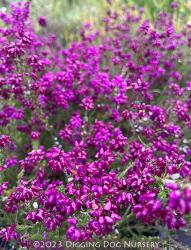
It was a British couple, Mr. and Mrs. Letts, whose keen eyes first noted this summer-flowering beauty in the wilds of Cornwall and later introduced it. Ample-sized, more than abundant and long blooming, the luminous amethyst flowers sparkle like jewels upon the vigorous dark green needle-like foliage that defines ‘Purple Beauty’s exquisite, low bushy form.
Blooms June–October
Size: 12" high x 22" wide.
Hardy to zone 5.
Erica x darleyensis ‘Furzey’ (S-0018)
Each $12.00
Erica x darleyensis ‘Kramer’s Red’ (S-0564)
Each $12.00
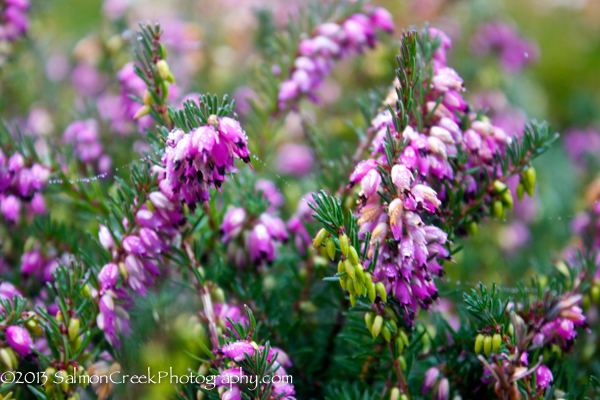
Named for Kurt Kramer of Germany, this ornate Heath’s plushly colored flowers outclass most other Erica cultivars. Stiff branches hold dark green foliage, enhanced in winter by bronze highlights and closely set chartreuse buds that open into cerise-magenta blooms.
Blooms November–January
Size: 15" high x 2' 0" wide.
Hardy to zone 5.
Erica x darleyensis ‘Margaret Porter’ (S-0019)
OUT OF PRODUCTION AT THIS TIME
Email me when this plant is available
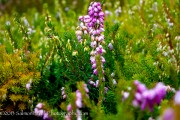
We have Ireland’s James W. Porter to thank for this attractive low spreading Erica. Light-colored buds precede dainty deep lilac urns, studding ‘Margaret Porter’s attractive mid-green needles, which burnish bronzy hues during the winter months.
Blooms January–May
Size: 10" high x 2' 0" wide.
Hardy to zone 5.
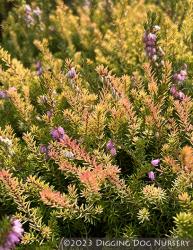
Discovered as a chance seedling at the British nursery, Holden Clough, and named for the owners’ daughter, this outstanding well-formed cultivar is distinguished by erect racemes of dainty rose-pink blooms and lucent short-needled golden-yellow leaves that brandish warm bronze shades during the colder months. The x darleyensis hybrids combine ironclad constitutions with innate good looks, conquering variable moisture levels plus an array of soil types far better than most Ericas, and spirited ‘Mary Helen’ is a fetching example. Highly effective when massed, her stylish countenance lends colorful year-round allure to a stone wall, Heather garden or mixed border.
Blooms February–April
Size: 10" high x 18" wide.
Hardy to zone 5.
This lambent Erica ‘W. T. Rackliff’ sport was introduced by nursery owner John Letts in 1964. Sprinkled with urn-shaped pure white blooms, ‘Golden Lady’ develops a shapely low mound of fine textured needle-like foliage, colored in light yellow, gold, chartreuse and green hues that persist throughout the year.
Blooms January–April
Size: 10" – 18" high x 10" – 18" wide.
Hardy to zone 7.
Erica vagans ‘Mrs. D. F. Maxwell’ (S-0607)
Each $12.00
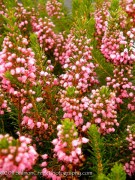
Applauded throughout the world as one of the most cherished Heaths, this Erica’s deep cherry red blooms have as much charm as the story behind them. Mrs. Maxwell’s discerning eye first spotted its robust good-looking form while on her honeymoon in Cornwall, England and promptly sent home cuttings! Elevated above a low, deep green bush, the long upright racemes of cylindrically arranged, irresistible blooms open from the bottom up and when spent, persist through the winter burnished in russet brown hues.
Blooms July–September
Size: 18" – 2' 0" high x 2' 0" – 2-1/2' wide.
Hardy to zone 5.
Calycanthus
Sweetshrub, Spice Bush
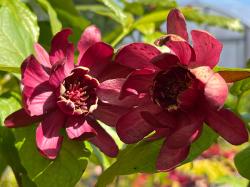
The fruity fragrance of ‘Aphrodite’s magnificent, 4 in. wide, Magnolia-style deep red blooms will lure you to her side. Distinguished by lambent golden-yellow fall colors, the lustrous dark green foliage cloaks a compact multi-stemmed habit, while the bark, leaves and seed pods all waft an enticing spicy scent when crushed. Second-to-none for cut arrangements, this floriferous beauty can be massed along woodland peripheries and house foundations, or staged as a long-blooming specimen near a patio, walkway or favored bench. Easygoing Calycanthus braves deer, dappled shade and variable soil types, including clay. Good drainage plus adequately moist, humus-enriched alcoves which are protected from cold, drying winds keep her satisfied. (PP#24,014)
Blooms May–July
Size: 5' 0" – 8' 0" high x 5' 0" – 7' 0" wide.
Hardy to zone 5.
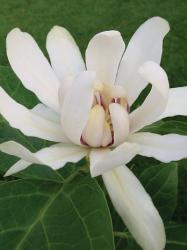
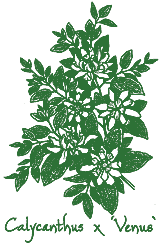
The crown jewel of Dr. Tom Rainey’s breeding efforts at North Carolina State University, this undeniably beautiful hybrid is a complex one, involving Calycanthus chinensis, Calycanthus floridus and Calycanthus occidentalis. Spreading branches draped in large, lustrous dark green deciduous leaves, which flash golden-yellow hues for fall, shape a medium-sized foundation. Distinguished by a central infusion of yellow and purple markings plus a divine spicy fragrance, evoking strawberries and melons, the exquisite, 4 in. wide Magnolia-like ivory blooms unfurl from big creamy-yellow buds primarily in the spring, and then sporadically throughout the growing season. ‘Venus’ can pose amongst other shrubs or serve as a beckoning sentinel near your front door; well-drained soil and ample light will ensure her vitality. (pp#15,925)
Blooms May–July
Size: 5' 0" – 6' 0" high x 5' 0" – 6' 0" wide.
Hardy to zone 5.
Carpenteria
Mock Orange
Carpenteria californica ‘Elizabeth’ (S-0193)
OUT OF PRODUCTION AT THIS TIME
Email me when this plant is available
First discovered by Colonel John Charles Fremont, this elegant evergreen was considered by the British to be “one of the most splendid acquisitions from the Californian flora.”
Fragrant yellow-eyed, double white flowers that resemble Japanese Anemones embellish gorgeous flaking bark and thick, dark green linear leaves sporting a lustrous sheen on top and a whitish down on their undersides.
Peerless as an understory for taller trees or as a backdrop for perennials, ‘Elizabeth’ can be found growing along hillsides in California’s Fresno County and is happiest in cool, moist and well-drained abodes with protection from the hot afternoon sun, though once established it can handle some drought.
Blooms May – June.
Size: 3' 0" – 6' 0" high x 3' 0" – 6' 0" wide.
Hardy to zone 9.
Caryopteris
Bluebeard
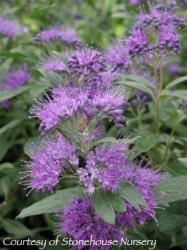
Tiny round buds and vibrant cut-flower-perfect whorled blooms put on a spectacular display, nearly enveloping the fine textured bushy foundation that’s defined by compact upright stems and pewter-green leaves with frosted flip sides. Touted as the best and the bluest of all Caryopteris, ‘Dark Knight’s swank low mounding profile can be staged right up front, tucked next to Rudbeckia ‘Viette’s Little Suzy’ and Achillea ‘Hella Glashoff’ or ushered into smaller gardens.
Blooms July–September
Size: 2' 0" – 3' 0" high x 18" – 2' 0" wide.
Hardy to zone 5.
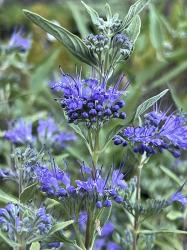
An unparalleled cultivar selected at Longwood Gardens in Pennsylvania, this well-groomed Caryopteris touts a taller upright stance with boundless, fragrant blue-violet flowers and dashing silver-dusted gray foliage. Lavish quantities of long-lasting late summer blooms, housed in terminal and axillary clusters, bewitch bees, butterflies, florists and gardeners, while the slender lance-shaped deciduous leaves waft enticing spicy aromas. Easy-care ‘Longwood Blue’ looks impressive whether it’s trimmed into a low hedge, planted en masse or featured as a specimen in the perennial border.
Blooms July–September
Size: 2' 0" – 4' 0" high x 2' 0" – 4' 0" wide.
Hardy to zone 5.
Caryopteris x x ‘Lissilv’ (S-0732)
OUT OF PRODUCTION AT THIS TIME
Email me when this plant is available
(Sterling Silver™)
We have esteemed English shrub breeder, Peter Catt to thank for the exceptional attributes this award winning Caryopteris promotes: small stature, elegant illuminated foliage and copious late season blooms. Whorled bright blue-violet flowers garnish a trim gathering of shimmering silver leaves that draws attention months before the blossoms appear.
An ideal addition to the mixed border, its sterling shades can be combined with the yellow umbels of Achillea ‘Hella Glashoff’ or boldly mixed with orange flowering Leonotis ‘Savannah Sunset’. (PPAF)
Blooms August – September
Size: 18" – 2' 0" high x 3' 0" wide.
Hardy to zone 5.
Englishman Peter Catt bred sterling qualities into this easy-to-care-for Caryopteris: deep, vivid blue blossoms, an earlier, extended bloom period, and a neatly compact form that requires little pruning. ‘First Choice’ also earns its place for winning whorls of inky flowers, which emerge from the leaf axils along the upper part of each erect stem. Serrated, with a green sheen topside, the linear leaves are a soothing gray-green beneath. Blue Mist Spiraea offers arresting texture and color when staged with the toasty hues of Sedum ‘Autumn Fire’ and Spodiopogon sibiricus.(PP#11,958)
Blooms July–September
Size: 3' 0" high x 3' 0" wide.
Hardy to zone 5.
OUT OF PRODUCTION AT THIS TIME
Email me when this plant is available
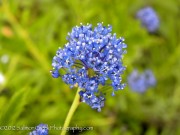
One of the oldest and most dazzling of all Ceanothus hybrids, ‘Concha’ premiers a spectacular spring display of deep cobalt blue clustered flowers unfurling from tight pinkish red buds. Gracefully arching branches can withstand light pruning and are clad in lustrous, small dark green textured leaves, which etch an attractive evergreen foil.
Persisting some 15 to 25 years in a well-drained site with little or no irrigation, but amiable to minimal summer water and heavier soils, this adaptable Ceanothus can be employed as a dense hedge, a specimen shrub or for erosion control on slopes. Birds savor its seeds and seek its stately shelter, while Mediterraneans make worthy companions.
Blooms April – May
Size: 5' 0" – 7' 0" high x 6' 0" – 10' 0" wide.
Hardy to zone 7.
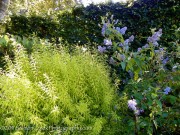
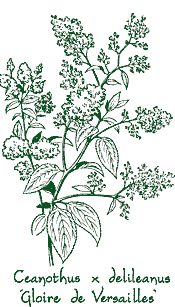
Large, finely toothed glossy green foliage bolsters profuse eye-catching panicles of scented, butterfly friendly powder-blue flowers. A prized outcome from a French breeding program, developed by crossing C. americanus and C. coeruleus, this unique long-blooming cultivar forges a handsome, rounded deciduous habit that handles hot humid weather, prefers moderate moisture and well-drained abodes plus resists rabbits and deer. Try planting it as a hedge or a specimen in a mixed border with white Lavender and yellow flowering Phlomis russeliana nearby and you’ll see why it came to be called the ‘Glory of Versailles’.
Blooms June –August
Size: 6' 0" high x 6' 0" wide.
Hardy to zone 6.
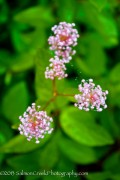
The heritage of this versatile hybrid is uncertain, but her reputation as a flirty, long blooming semi-evergreen is widespread. Amid speculation about an additional cross between x delileanus and the eastern species, Ceanothus ovatus, ‘Marie Simon’ is not adversely affected by summer watering, which is unusual for a Ceanothus.
Try planting her in the mixed border, where she flaunts a decidedly feminine display of fluffy rose-pink panicles and ornamental red seed capsules cushioned by wine-colored stems and long, serrated leaves.
Blooms June–October.
Size: 5' 0" high x 5' 0" wide.
Hardy to zone 6.
Cercis
Redbud
An American native from Texas and Oklahoma, this hard-to-find deciduous subspecies combines floriferous good looks with a rugged temperament. Compact stems, which are shorter, thicker and more rigid than the species, form a dense, widely rounded foundation, showcasing masses of bright pinkish purple flowers in early spring followed by intriguing slim, violet-hued seed pods. Broad heart-shaped green leaves don distinctive wavy margins and a gleaming leathery blue finish. Especially acquiescent to high soil pH and dry conditions, Mexican Redbud can be utilized in water wise gardens alongside other toughies such as Hypericum f. ‘Sunburst’ and Arctostaphylos ‘Vancouver Jade’.
Blooms March-April
Size: 12' 0" – 15' 0" high x 8' 0" – 10' 0" wide.
Hardy to zone 6.
Cercis chinensis ‘Don Egolf’ (S-0742)
OUT OF PRODUCTION AT THIS TIME
Email me when this plant is available
Named in honor of the illustrious American shrub breeder Don Egolf, this compact free flowering treasure has a lot to offer. Its clustered, bright rosy mauve blooms gather “stem to stern”, orchestrating an abundant spring display that nearly engulfs the attractive multibranched frame.
Thankfully incapable of spawning unwanted seedlings, the vibrant nonfruiting flowers herald heart-styled, dark green deciduous leaves. Unfazed by hot dry conditions and different soil types, but sensitive to poorly drained sites, ‘Don Egolf’ exhibits excellent disease and pest resistance and makes a stellar slow growing specimen for the smaller garden, a shrubby border or the woodland’s edge.
Blooms April – May.
Size: 8' 0" – 9' 0" high x 8' 0" – 9' 0" wide.
Hardy to zone 6.
Each $14.75
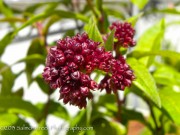
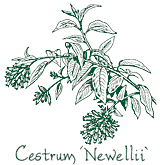
Beloved by bees, butterflies and hummingbirds, this lush Central and South American member of the Potato family has a colorful allure nearly all year round. Arching stems coated with mahogany-colored fuzz carry profuse nodding clusters of waxy, deep red tubular flowers plus purplish red berries dramatically set amid burgundy-tinged leaves, which are soft as velvet and taper to a point. A vigorous tall-standing evergreen shrub that’s well-suited for a container, ‘Newellii’ blooms summer through winter and in some instances much longer. Red Cestrum appreciates moderate moisture, a protected wall or overhang, partial shade on hot afternoons and a light to heavy pruning to maintain its shape.
Blooms May–November
Size: 6' 0" – 8' 0" high x 3' 0" – 5' 0" wide.
Hardy to zone 9.
Cestrum ‘Orange Peel’ (S-0836)
Each $14.75
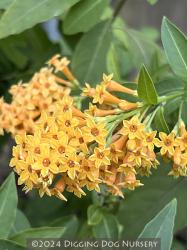
An irresistible mecca for bees, hummingbirds and designers, copious loose bouquets of tubular ocher and orange-colored blossoms with yellow star-shaped tips unfurl from early spring ’til frost, exuding unbeatable ebullience and a sweet scent at dusk. The appealing, deer-resistant Ligustrum-style foliage plus long, fast developing, woody stems remain evergreen in Zone 8b, but become deciduous and temporarily die back in colder locales. Related to potatoes and easy to cultivate, this heat-loving Cestrum diurnum and Cestrum nocturnum hybrid sprouts a billowing, multistemmed bearing that can be ensconced in containers, espaliered against sheltered walls and staged either singularly or massed in well-drained mixed planting schemes.
Blooms June–October
Size: 6' 0" high x 4' 0" wide.
Hardy to zone 7.
Chaenomeles
Quince
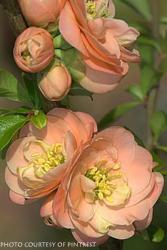
Quince were once coined “one of the most precious and invaluable of the early flowering shrubs” by British author, Mrs. C. W. Earle, so it’s no surprise ‘Cameo’ headlines many gardeners’ top ten lists. Heralding winter’s end, gorgeous double flowers with soft apricot pink shades are poised in stalkless clusters on thick, springy bare branches. Later, fine-toothed deciduous foliage hosts pleasantly perfumed edible reddish yellow fruit, commonly utilized for delicious preserves and as a Chinese remedy for inflammation since 500 A. D. Acquiescent to drought and clay soil, though happiest when allotted a sunny well-drained site, this preeminent cultivar crafts a dense, compact thicket that can be easily maintained along a trail or dramatically spotlit against a wall.
Blooms March–April
Size: 4' 0" – 5' 0" high x 3' 0" – 5' 0" wide.
Hardy to zone 4.
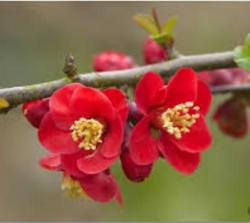
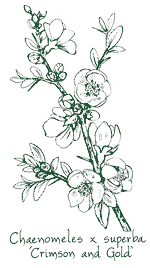
Coveted for its close-knit habit and galvanizing deep crimson-red flowers which flaunt showy golden anthers, this bold cultivar has been gracing gardens since 1939. Plentiful cup-shaped blooms are borne on naked twigs well before the lustrous dark green cloak of deciduous foliage appears. ‘Crimson and Gold’s low spreading, more easily managed habit can be espaliered against a wall, while its perfumed greenish yellow fruit makes a zesty addition to pies, jelly and lemonade.
Blooms March–April
Size: 2' 0" – 3' 0" high x 2' 0" – 3' 0" wide.
Hardy to zone 4.
Chaenomeles x superba ‘Texas Scarlet’ (S-0488)
Each $14.00
Introduced by a German nursery in 1900, this intrepid japonica and speciosa hybrid blazes early flame-red clusters of cup-shaped, gold-eyed flowers on bare, densely interwoven twig-like branches. Small fragrant yellow-green fruit, perfect for jellies and preserves, appear after the profuse sassy blooms fade, while obovate, glossy dark green leaves cloak the compact bushy mound. Delighting bees, birds, floral designers and bonsai enthusiasts, vigorous ‘Texas Scarlet’ can be massed, espaliered, featured as a deciduous specimen, clipped into a low flowering hedge and added to slope, barrier or foundation plantings. It prefers sunny, well-drained sites with average moisture, yet heroically tackles rabbits and deer, occasional dry periods plus various soil types, including clay.
Blooms March–April
Size: 3' 0" – 4' 0" high x 3' 0" – 4-1/2' wide.
Hardy to zone 5.
Chamaecyparis lawsoniana ‘Nidiformis’ (S-0846)
OUT OF PRODUCTION AT THIS TIME
Email me when this plant is available
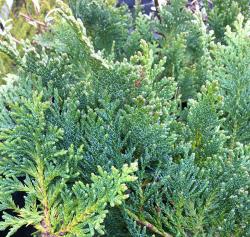
The cultivar name of this seldom offered native Port Orford Cedar selection pays homage to its signature bird’s nest form. Draped in exquisite, finely dissected gray-green foliage that’s dusted with blue, the artfully cascading branches craft a dense, slow growing, small-statured mound. Craving sharp drainage, acidic soil, moderate moisture plus protection from hot afternoon sun, deer-resistant ‘Nidiformis’ is unparalleled in the rockery or in a mixed border. It can be utilized as a lacy-looking container specimen as well as a petite evergreen bonsai subject.
Size: 3' 0" – 4' 0" high x 5' 0" – 6' 0" wide.
Hardy to zone 5.
Chimonanthus
Wintersweet
OUT OF PRODUCTION AT THIS TIME
Email me when this plant is available
Wintersweet’s spicy smelling, wonderfully strange flowers make it one of the finest shrubs for winter effect. Borne on stiff naked stems, nodding waxy blooms produce a double row of petals: the outer pale yellow ones, nearly translucent and somewhat cupped, while the inner petals showcase purplish maroon streaks. Yielding sweetly scented essential floral oils employed in perfumes, sachets and tea flavorings, this beguiling Chinese denizen forges a rounded thicket-like deciduous green frame, cloaked with opposite, rough textured lance-shaped leaves. C. praecox, cultivated since 1000 BC, is enjoyed today near a threshold, south-facing wall or frequently trodden pathway, where it accepts either acidic or alkaline soil, but flourishes in bright well-draining sheltered abodes and requires little care.
Blooms December–February
Size: 8' 0" – 10' 0" high x 10' 0" wide.
Hardy to zone 7.
Choisya ‘Aztec Pearl’ (S-0562)
Each $14.25
Valued for its fragrant flowers and aromatic, evergreen foliage, this elegant small shrub is a hybrid bred to life by Peter Moore, Hillier’s propagator. The white blossoms burst forth in profuse clusters from pink buds. Almost almond in scent, they are hosted terminally on slender, glossy and trifoliate dark green leaflets.
Resistant to deer, ‘Aztec Pearl’s handsome rounded visage will form a close-knit and finely textured low screen or informal blooming hedge in your garden.
Blooms June–July.
Size: 4' 0" – 5' 0" high x 4' 0" wide.
Hardy to zone 8.
Choisya x dewitteana ‘Limo’ (S-0790)
Each $14.25
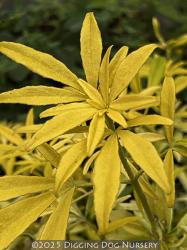
Sharing the same Choisya arizonica and Choisya ternata lineage and plant breeder (gifted British horticulturist Peter Moore) as ‘Aztec Pearl’, this dazzling evergreen cultivar is similar to its green-leafed relation save for its lambent gold-dusted foliage. Large citrus-scented clusters of terminal white blooms decorate the polished, palmately divided leathery leaves that emit a strong aroma. Bushy, rounded and generally pest free, ‘Limo’s tailored mien savors dappled light and free-draining locations plus serves as a brilliant counterpoint to dark greenery.
Blooms March–May
Size: 3' 0" – 4' 0" high x 3' 0" – 4' 0" wide.
Zone 7b.
Cistus

Rockrose
Rockroses hail from the Mediterranean region and fortunately prosper in our mild climate. These stalwart evergreens are famed for their conspicuous, papery single flowers, resembling wild rose blossoms. Though they last only a day, they arrive in such profusion, carpeting the ground beneath, that one can count on color for 2 or 3 months. Fast growing and appreciative of well-drained sites, they tolerate drought, poor soil, ocean winds, salt spray and even desert heat. Cistus vary from low spreaders to tall imposing bushes, and are terrific for informal hedging and screens.
Cistus x aguilarii ‘Maculatus’ (S-0603)
Each $14.75
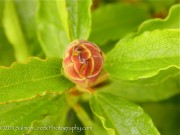
We favor this upright, robust Cistus for its decorative leaves and large showy flowers. A Cistus ladanifer and Cistus populifolius hybrid backcrossed once again with Cistus ladanifer, ‘Maculatus’s foliage is fastened by reddened petioles, tapers to a point and features margins so evenly rippled that the edges are pulled up. The intriguing slender greenery elevates 3 in. wide, billowy white blossoms whose closely arranged petals flaunt a striking, almost triangular, wine-colored mark at their bases while encircling a bright gilded hub of stamens.
Blooms late April–mid-July.
Size: 6' 0" high x 4' 0" – 5' 0" wide.
Hardy to zone 8.
Each $14.75
Olivier Filippi, guardian of the French National Cistus collection, kindly gave us this delightful Eric Sammons hybrid. A robust descendant of Cistus dansereaui ‘Decumbens’, ‘Ann Baker’ is pleasingly attired with delicate, white saucer-shaped flowers, centered by a singular sanguine marking and a small yellow splash on each petal. Slightly undulating and lacking petioles, the handsome, dark green leaves clasp arching, red-tinged stems.
Noteworthy for blooming later than most other Rockroses, ‘Ann Baker’ prolongs the flowering period well into September, and is a welcome addition to the Mediterranean garden alongside Lavender, Rosemary, and other Rockroses.
Blooms May–September.
Size: 2-1/2' – 3-1/2' high x 5' 0" wide.
Hardy to zone 8.
Each $14.75
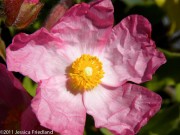
Silvery pink, crepe paper-like petals float over the ripple-edged gray-green foliage of this tasteful, low growing evergreen shrub. Equally at home in tough coastal or inland environments, ‘Anne Palmer’ makes a memorable companion for Salvia ‘Waverly’ and Lepechinia hastata.
Blooms May–September
Size: 2-1/2' – 3' 0" high x 6' 0" wide.
Hardy to zone 8.
This well-mannered Cistus wins a place in our garden for its neat rounded habit that stays relatively small. Knitting a handsome upright foil, the easily shorn, maroon-tinted stems plus small, wavy and textured gray-green leaves parade countless 1 ½ in. blooms with prominent golden eyes and white parchment-like petals tinged pale yellow at each base.
Blooms June–July
Size: 3' 0" – 4' 0" high x 3' 0" – 4' 0" wide.
Hardy to zone 8.
Cistus x dansereaui ‘Decumbens’ (S-0413)
Each $14.75
An excellent shrubby ground cover, this Cistus displays luminous flowers against a vigorous and glossy dark green foil of curvy-margined, lance-shaped leaves. Each ornate snowy-white petal is elegantly stamped with a prominent burgundy blotch at its base.
Blooms May–July
Size: 2' 0" high x 4' 0" wide.
Hardy to zone 8.
Cistus x dansereaui ‘Jenkyn Place’ (S-0621)
Each $14.75
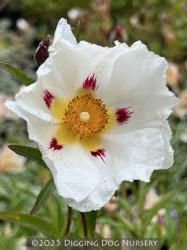
A merlot-colored triangular brush stroke boldly brands each overlapping tissuelike petal, etching a distinctive 5-pointed star with a pronounced golden center. Large blossoms, spanning 3 snowy white in. across, are cupped, rimpled and renown for their long lasting flowery pomp.
Named after a private English garden and parented by Cistus ladnifer and Cistus inflatus, ‘Jenkyn Place’s small vigorous frame blends shapely red-tinged green stems and narrow sticky, pucker-edged deep green leaves that smell spicy and taper toward their tips.
Blooms April – July.
Size: 4' 0" – 5' 0" high x 4' 0" – 5' 0" wide.
Hardy to zone 8.
Cistus ‘Jessamy Beauty’ (S-0690)
Each $14.75
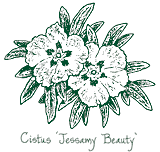
Created and named by British Cistus aficionado, Eric Sammons, this Cistus ‘Little Gem’ and Cistus laurifolius cross celebrates not only showy blooms but a low comely mound, which responds well to pruning. The gold-centered, 2-½ in. white papery flowers are engraved with striking, nearly triangular burgundy marks at each petal’s base, while gracing long, matt-finished, dark green slender leaves and somewhat lax, wine-infused stems.
Full of vigor, ‘Jessamy Beauty’ merits her name especially when set against Melianthus ‘Antonow’s Blue’s large blue-tinged foliage.
Blooms June – July.
Size: 3' 0" high x 5' 0" wide.
Hardy to zone 8.
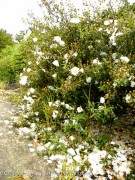
From a distance, this Cistus’ 5 in. wide pure white flowers could easily be mistaken for those of a Romneya. Unusually large, frilly gold-centered blooms deliver a show-stopping presentation against cinnamon-colored stems and two-toned leathery leaves, which are a glistening dark green on top and silver beneath. Yielding a sticky sweetly fragrant resin known as Labdanum, vigorous growing ‘Bennett’s White’ can be planted with Lavandula ‘Ana Luisa’ in a dry Mediterranean garden where its amazing flowers and pleasant aroma will undoubtedly turn quite a few heads.
Blooms April–May
Size: 4' 0" – 5' 0" high x 4' 0" wide.
Hardy to zone 8.
Cistus x lenis ‘Grayswood Pink’ (S-0412)
Each $14.75
Attractive curvy-edged, ovate leaves make a low growing smoky-green foil for the springtime plethora of pretty 2 in. wide, soft pink blooms that are brightened by white centers and ebullient yellow stamens. A tidy mounding evergreen, ‘Grayswood Pink’ can accompany other Mediterraneans along a path so you can easily admire its charm.
Blooms May–June
Size: 2' 0" – 3' 0" high x 0" wide.
Hardy to zone 8.
Each $14.75
A refined Eric Sammons hybrid of Cistus inflatus parentage and distant Cistus ladanifer ancestry, this small-statured Cistus presents delicate white flowers. A single dark maroon mark is attractively painted at the base of each petal, enhancing the sunny yellow center. Lining red-tinged stems, the textured linear leaves are slightly reflective and provide a contrasting foil for Helianthemum ‘Cheviot’.
Blooms May–June.
Size: 3' 0" high x 4' 0" wide.
Hardy to zone 8.
Cistus monspeliensis ‘Vicar’s Mead’ (S-0636)
Each $14.75
Dotted with soft yellow, one inch wide, paper-thin blooms, this splendid Rockrose celebrates a flower color that is pleasantly unique! Rose-scented, overlapping petals swirl around a sunlit hub, while slender green leaves—long, tapering and ripple-edged—garb its small, well-branched frame. Collected on the Mediterranean island of Majorca by Harold Read, ‘Vicar’s Mead’ makes an airy evergreen companion for Isoplexis canariensis.
Blooms April–May.
Size: 4' 0" high x 3' 0" wide.
Hardy to zone 8.
Cistus x oblongifolius ‘’ (S-0604)
Each $14.75
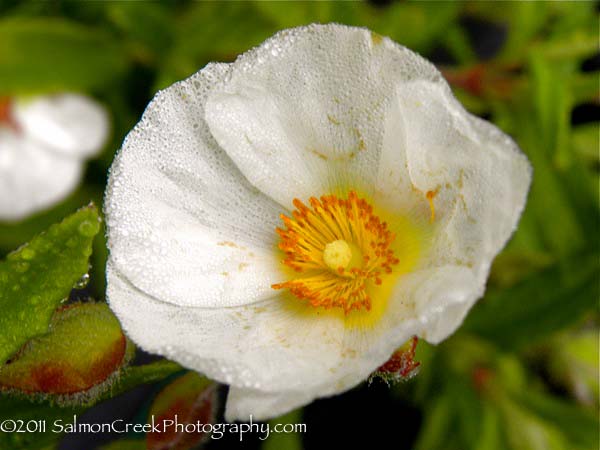
With overlapping, sheet white petals drawn together by prominent, golden clusters of stamens, the jubilant-looking, 2 in. wide flowers remind us of sunnyside-up eggs. A Cistus laurifolius and Cistus inflatus progeny, this vigorous, tall growing Cistus hosts long and pointed, dark green leaves that are gray-green below, narrowly shaped and sticky. Its sizable presence, handsome foliage and perky floral display makes it a good neighbor for Rhamnus ‘Variegata’.
Blooms late
Size: 6' 0" high x 4' 0" – 5' 0" wide.
Hardy to zone 8.
So named because of the ½ in. blood red spot at the base of each good-sized, paper-thin white petal, this dense, striking Cistus comes to us from Ken Montgomery of Boonville, California. Its deep green, glossy linear leaves and young stems are fragrant and sticky to the touch. Bold, deer resistant and adorned with eight-chambered brown seed pods, ‘Red Eye’ deserves to be displayed as a specimen.
Blooms March–May.
Size: 5' 0" high x 5' 0" – 6' 0" wide.
Hardy to zone 8.
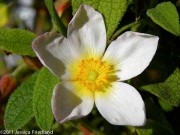
With a high-born lineage that includes Cistus parviflorus and Cistus salviifolius, it’s no wonder this seldom offered, easy-to-maintain Cistus is shapely and small statured, unlike so many other Rockroses. ‘Natacha’ displays handsome textured gray-green foliage and delicate pink-tinged, yellow-centered white flowers. Stimulated by pruning, her rounded profile makes a superb companion for more diminutive plants like Ballota pseudodictamnus and Calamagrostis foliosa.
Blooms April–June
Size: 4' 0" high x 4' 0" wide.
Hardy to zone 8.
Each $14.75
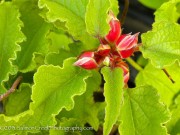
The unique apple green foliage has decorative rippled margins and comprises dense hearty mounds, creating a luxurious backdrop for its yellow-centered white flowers. Big red-hued buds appear in late winter and look stunning with the verdant leaves and springtime tissue-thin blooms.
Blooms April – June.
Size: 6' 0" high x 6' 0" wide.
Hardy to zone 8.
Cistus x purpureus ‘Alan Fradd’ (S-0652)
Each $14.75
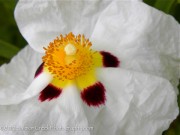
Achieving the delicacy of parchment, each white overlapping petal features a striking maroon brush mark at its base. The large flowers are drawn together by a predominant yellow eye, while poised amongst wavy, dark green narrow leaves. Upright and sticky, red-flushed stems forge a rounded profile that can be associated with Perovskia abrotanoides and Eryngium ‘Blaukappe’ for an arresting union.
Blooms May–June.
Size: 5' 0" – 6' 0" high x 5' 0" – 6' 0" wide.
Hardy to zone 8.
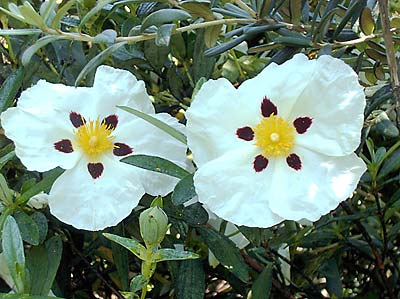
Regarded by Eric Sammons as perhaps the most successful of his unreleased hybrids, this well-bred Cistus is a progeny of Cistus populifolius subsp. major and Cistus inflatus. ‘Snow Fire’ grows into a medium-sized shrub embellished with illuminated blooms, whose blazing marks undoubtedly kindled the “fire” in its cultivar name. Dainty white overlapping petals surround a golden eye, and each is etched by a vivid wine-red patch at the base, while wavy rich green leaves and reddish stems respond quite well to pruning.
Blooms April–August
Size: 4' 0" – 4-1/2' high x 4' 0" – 5' 0" wide.
Hardy to zone 8.
Each $14.75
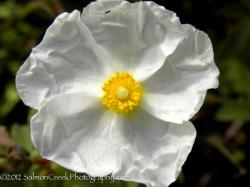
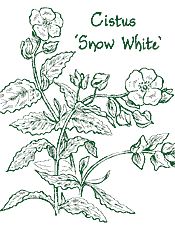
The name ‘Snow White’ surely refers to the multitude of orange-centered, papery white flowers that embellish this choice mounding Cistus. Perhaps even more noticeable are the large, intricately-winged buds. Deep red in color, and covered with a downy fuzz, they nearly obscure the bright green, undulating foliage for most of the season, adding to its soft, alluring appearance.
Blooms April-August
Size: 6' 0" high x 8' 0" wide.
Hardy to zone 8.
Clerodendrum
Glory Bower
Clerodendrum trichotomum (S-0743)
OUT OF PRODUCTION AT THIS TIME
Email me when this plant is available
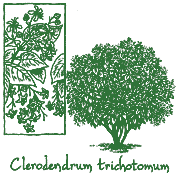
A denizen of China and Japan, this exotic large deciduous shrub has a big impact. Clothed with fuzzy dark green oval leaves, the sparse upright branches and pendulous lower ones define its elegant, often multitrunked silhouette. Gracefully drooping terminal panicles of slightly upturned white flowers make a sweetly perfumed late summer appearance. Tended by large pinkish green prominently ribbed calyxes, the blooms age to a pale mauve and are followed by extraordinary jewel-like, small steel blue fruit cradled in star-shaped magenta calyxes.
Harlequin Glorybower is a sublime contender for the mixed border or a large patio pot, where it fancies full sun and moist well-drained soil.
Blooms August – September
Size: 10' 0" – 12' 0" high x 10' 0" – 12' 0" wide.
Hardy to zone 7.
Clethra
Summersweet
Clethra alinifolia ‘Hummingbird’ (S-0217)
Each $17.25
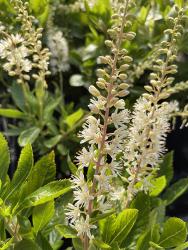
Exhibiting the four-season fanfare of its deciduous eastern U.S. relations, this adaptable low-maintenance Clethra offers additional enticements: a more compact, smaller scale habit plus nearly twice as many blooms! Shiny serrated dark emerald foliage hosts the abundant summertime creamy-white flowers. Cherished by butterflies and bees, dazzling nectar-rich 4 to 6 in. long blooms form upright, close-knit cylindrical spires that waft a delectable spiced-honey scent. Autumn brings glowing golden-yellow leaves, while the densely woven brown branches etch winter’s landscape and persistent dark cocoa-hued seed spikes nourish songbirds. Appreciative of bright shade coupled with somewhat acidic, moderately moist sandy soil, ‘Hummingbird’s winning rounded character is tailor-made for containers, streamsides, shrubby borders, massed plantings or woodland gardens, where it heroically abides clay, deer and full shade as well as wet conditions.
Blooms July–August
Size: 2' 0" – 4' 0" high x 3' 0" – 5' 0" wide.
Zone 3b/4.
Clethra alnifolia ‘Ruby Spice’ (S-0456)
Each $17.25
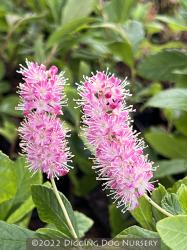
A friend to gardeners, butterflies and bees alike, ‘Ruby Spice’ celebrates a compact well-groomed visage plus long-lasting bottlebrush-like rosy-pink flower spikes that sweetly perfume the dog days of summer. Lustrous, deep green serrated leaves develop yellow, gold and chocolate autumnal hues, while the delightful narrow upright panicles morph into intriguing dark brown seed capsules. Discovered in 1992 as a sport of Clethra alnifolia ‘Pink Spire’, this winsome deciduous cultivar exhibits outstanding easy-care versatility, tolerating both full sun and full shade. Whether massed, displayed as a specimen or hedged, it is invaluable for patios, smaller spaces, woodlands, cottage gardens and mixed borders.
Blooms August–September
Size: 4' 0" – 6' 0" high x 3' 0" – 5' 0" wide.
Hardy to zone 4.
Each $17.25
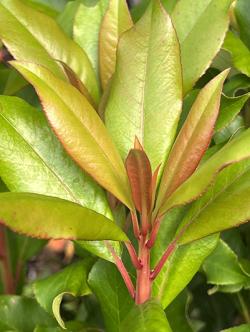
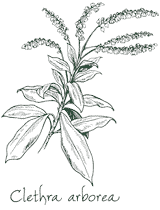
A resident of the Madeira Islands, this winsome evergreen is densely attired in lustrous coppery green 4 to 6 in. long leaves. Copious small white fragrant flowers, resembling Lily-of-the-Valley blooms, embellish large showy rose-tinged panicles that cluster at branch tips from summer to fall and sustain our interest with round long lasting auburncolored seed heads. Tailormade for narrow sheltered spaces, Clethra arborea's wellgroomed upright frame requires protection from hard freezes and savors moist, freely draining acidic soil.
Blooms August – October
Size: 15" – 20" high x 8' 0" wide.
Hardy to zone 8.
Clethra ‘Sixteen Candles’ (S-0585)
OUT OF PRODUCTION AT THIS TIME
Email me when this plant is available
Just like candles on a birthday cake, the larger, more upright flowers of this superlative Michael Dirr selection are a splendid sight. A glossy late spring flush of tooth-edged leafage in emerald hues sets the stage for the abundant creamy white flowers. Made even more dazzling by their spiced-honey scent, the 6 in. long blooms form nearly horizontal, close-knit cylindrical spires.
In autumn, foliage matures to a pleasing yellow. Strongly vertical, slightly downy brown branches and persistent seed spikes etch winter’s somber landscape. With a compact mounding habit, this Clethra offers a winsome presence in small spaces, and is a choice feature for a patio pot. Give this easy-to-grow shrub moist, slightly acidic soil and, where summers are hot and dry, shade each afternoon.
Blooms late June–July
Size: 2-1/2' high x 3' 0" wide.
Hardy to zone 4.
Convolvulus
Bush Morning Glory
Gleaming with narrow sleek silver leaves, this rounded evergreen bushette rallies a delicate summer showing of plentiful pink buds plus rose-blushed white trumpets heightened by yellow throats. A carefree Mediterranean denizen, ‘Snow Angel’ lends effulgent fine-textured accents to the rockery, good-sized containers and mixed plantings, where it tackles heat, poor soil and dry sites. Moderate water, shelter from temperatures below 15° and well-drained niches ensure its prosperity.
Blooms May–September
Size: 2' 0" – 4' 0" high x 3' 0" – 4' 0" wide.
Zone 8b.
Coprosma
Valued for their handsome evergreen foliage and easy care even when the going gets tough, this well groomed genus hails from the Southern Hemisphere. Their rounded, leathery leaves are borne in opposite pairs and garb a fast growing, sun-loving frame that appreciates good drainage, handles drought, wards off deer and begs an easily viewed position anywhere fine foliar texture is appreciated.
Coprosma ‘Beatson’s Gold’ (S-0026)
Each $12.00
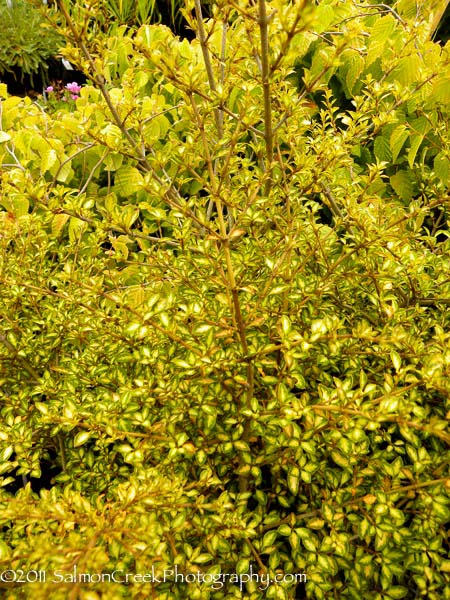
A twiggy stage where shadows and light become the cast, ‘Beatson’s Gold’ captivates an audience with variegated foliage and a distinctive horizontal branching pattern. The narrowly oval, tiny leaves are lime-yellow and rimmed by a crisp dark green. Stiff and upright, this handsome New Zealand native can be planted as a specimen, a formal or informal hedge or as a screen. It happily resides in coastal climates, obliging nearly any soil type, especially very dry ones.
Size: 8' 0" high x 6' 0" wide.
Hardy to zone 8.
Coprosma kirkii ‘Variegata’ (S-0586)
Each $12.00
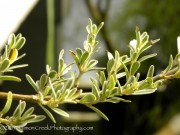
Because of the handsome horizontal growth of its long slender stems, and the exceptionally elegant variegation of its small lustrous leaves, this New Zealand native is a first-rate evergreen ground cover. Small, neatly cream-margined gray-green leaves display attractive, translucent white berries preceded by inconspicuous flowers. Its low-lying branches provide a deft transition between upright shrubs such as Rosmarinus ‘Herb Cottage’ or Cistus ‘Bennett’s White’.
‘Variegata’ willingly accepts a wide range of soils, can handle wind and salt spray, and promises a dense handsome form if pruned regularly.
Size: 12" – 2' 0" high x 4' 0" – 6' 0" wide.
Hardy to zone 8.
Each $12.00
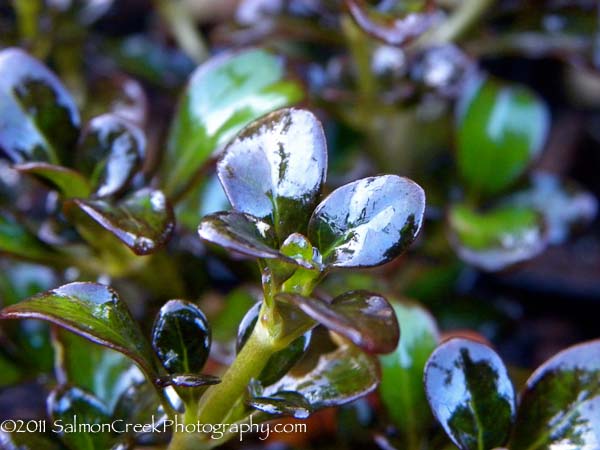
Accentuated by a marvelous surface so highly sheened it seems unreal, small, thick, almost succulent-looking foliage exhibits bronzy red and green hues. The lustrous, ovoid-shaped leaves angle upward while their tips curve down, and come winter transmute deep purply rubescent shades. Erect and not as wide-angled as ‘Beatson’s Gold’, light-colored reflective stems define a compact bushy shrub that casts cozy glimmers on Mediterraneans or fellow New Zealanders like Uncinia rubra or Carex tenuiculmis.
Size: 4' 0" – 6' 0" high x 3' 0" – 4' 0" wide.
Hardy to zone 8.
Cordyline australis ‘Red Star’ (S-0770)
OUT OF PRODUCTION AT THIS TIME
Email me when this plant is available
Bold, bronzed and tropical-themed, 'Red Star's long sword-shaped dark burgundy blades are applauded as the most handsome and the hardiest of the red-foliaged Cordylines. Endemic to New Zealand and eastern Australia, this winning palm-styled evergreen slowly forges an upright half-hardy vigorous frame that premiers large panicles of small sweetly perfumed flowers. Cabbage Palm's year-round drama can be staged as a water-wise focal point for a dry garden or ample-sized container, where it appreciates light shade with occasional water during intense heat and shelter from harsh winter weather. 10–15´ x 5–8´.
Blooms May–June
Size: 10' 0" – 15' 0" high x 5' 0" – 8' 0" wide.
Zone 8/9.
Cornus
Dogwood
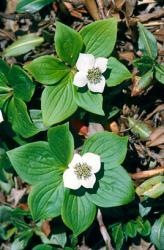
Gallivanting throughout the forests of Canada and the northern half of North America, this stylish herbaceous subshrub looks a bit like Cornus florida, though its luminous flowers and dark greenery are much smaller. The lush, whorled, deeply veined leaves, which sprout from spreading rhizomes, sculpt a low growing ground cover adorned with showy, upfacing, butterfly-friendly flowers, each defined by 4 oval-shaped, white bracts plus a tiny, central greenish yellow umbel. Bronzy-red fall color and ornamental, bright red berry-like fruit, eaten by birds and gardeners alike, offer added appeal. Second-to-none for naturalizing or edging wooded pathways, Bunchberry spurns deer and rabbits, detests hot, humid weather and enjoys dappled shade as well as slightly acidic, adequately moist soil.
Blooms May–July
Size: 6" – 8" high x 12" – 2' 0" wide.
Hardy to zone 2.
Each $16.00
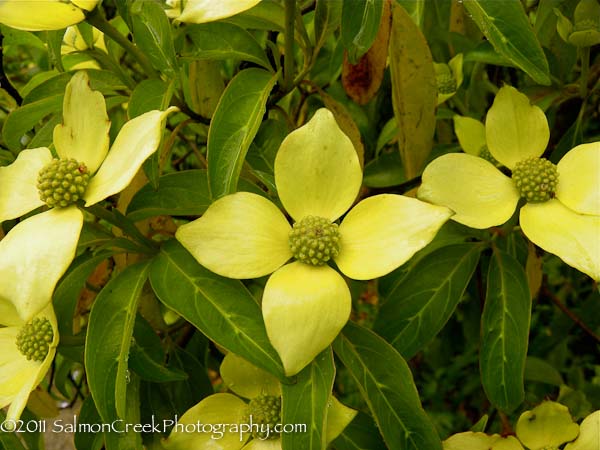
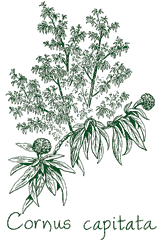
An elegant, large evergreen shrub or small tree, this slow growing Dogwood is a perfect anchor for the shrubby border. Handsome, curved leathery leaves with light green veins provide a pleasing texture and turn bronze in the winter months. Buttonlike flower heads surrounded by creamy yellow bracts precede the long lasting, prominent, pinkish red strawberry-shaped fruit that appears in November and can be brought inside as a colorful complement to holiday greenery.
Blooms June
Size: 16' 0" high x 8' 0" wide.
Hardy to zone 8.
Cornus kousa var. chinensis (T-0074)
Each $25.75
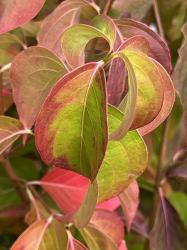
This sensational small, multistemmed tree presents year-round enticements. Cloaked with smooth, somewhat pubescent deciduous leaves, its rounded mien becomes a courtly dark green foil for multitudes of dazzling, petal-like creamy white bracts, many adopting tender pink blushes when they age. Autumn headlines eye-catching, reddish strawberry-style fruit amid scarlet and crimson foliage, while winter reveals dramatic exfoliating tan, gray and mahogany-mottled bark. Sensational when grouped in small groves or utilized as a specimen tree near patios, in woodland gardens and shrubby borders, Chinese Dogwood galvanizes birds, butterflies and gardeners alike, craves adequate water plus slightly acidic soil and appreciates enriched, well-drained quarters, but detests hot dry conditions.
Blooms May–June
Size: 15' 0" – 30' 0" high x 15' 0" – 30' 0" wide.
Hardy to zone 5.
Cornus sericea ‘Cardinal’ (S-0733)
OUT OF PRODUCTION AT THIS TIME
Email me when this plant is available
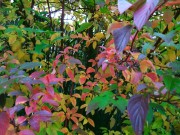
With common names like Hart’s Rouges, Kinnikinnik and Shoemack, who would expect this North American riparian native to be a vibrant beauty igniting the winter landscape? ‘Cardinal’ sculpts an unflappable, extremely cold-hardy multi-stemmed shrub that has a lot to offer: fiery red-hued stems in winter, flat-topped clusters of petite white flowers in spring, creamy white summertime fruit, and dark green deciduous foliage manifesting a purple-red fall display.
Beloved by gardeners, birds and the azure butterfly, the Red Osier Dogwood prefers rich, somewhat moist soil, but tolerates a variety of sites and can be ensconced near Acer griseum for an intriguing blend of colors and textures.
Trim roots to remove unwanted suckers and prune 30% of the old wood in early spring to stimulate brilliant new growth.
Blooms August – September
Size: 6' 0" – 8' 0" high x 6' 0" – 8' 0" wide.
Hardy to zone 3.
Each $15.75
The deep green leaves flashing white flip sides when the wind blows inspire this New Zealand shrub’s common name, while the genus is coined from the Maori name Korokio. Miniature arrowhead-like evergreen leaves scantily clothe a unique tangle of wide-angled, zig-zagging dark branches. Embellished by star-shaped fragrant yellow flowers and tiny red berries, the beguiling Ghost Plant attains a sculptural aspect that can be employed as a specimen near a pathway or utilized to view bold-colored plants through. Well-suited for containers, C. cotoneaster’s slow growing easy-care habit enjoys bright shade, warm sunny niches plus well-drained soil, yet abides occasional dry spells and seaside conditions.
Blooms June
Size: 5' 0" – 7' 0" high x 3' 0" – 5' 0" wide.
Zone 7b.
Correa
Australian Fuchsia
Pendulous droves of dainty tubular blooms resembling Fuchsias promise to tempt the hummingbirds in your garden, and enliven it with fall, winter and early spring color. These evergreen shrubs have attractive dense growth, often with down covered stems and foliage. A small group of Australian natives, Correa are exceptionally tough, tolerating drought, salt spray, poor soil, wind and deer, but beware of over watering them. Plant in a well-drained spot on a bank or in the mixed border, and provide shade in hotter climates.
Correa alba (Bronze Select) (S-0343)
Each $14.75
-709.jpg)
Everyone loves this chance evergreen hybrid from U.C. Davis, except those pesky deer. It makes a great windbreak, forming a dense, tidy mound of smooth topped, fuzzy bottomed leaves and soft rust-colored stems, while tolerating coastal breezes. Small white, star-shaped flowers borne at the leaf axils are a nice touch in the drab months of late winter. Beware of overwatering!
Blooms January – March.
Size: 8' 0" high x 8' 0" wide.
Hardy to zone 8.
Correa alba ‘Western Pink Star’ (S-0638)
Each $14.75
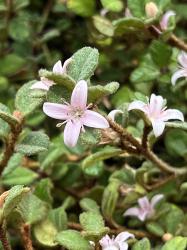
Hailing from Down Under, in Australia’s western Victoria on a limestone cliff top, it’s a happy chance that Mr. Pat Urbonus came upon this stalwart beauty. The tidy, semi-upright mound entertains a dainty gathering of pretty pink starry flowers, whitening as they age. Enveloped by a soft-looking rust-colored fuzz, the light stems and green oval-shaped leaves with pale gray-green undersides possess an untiring resilience to drought, wind, coastal frontlines, pesky deer and pruning. ‘Western Pink Star’ can be sited in a favored patio vessel or massed in a dry border amid Mediterraneans and grasses such as Stipa arundinacea.
Blooms May–June.
Size: 3' 0" high x 4' 0" – 6' 0" wide.
Hardy to zone 8.
Each $14.75
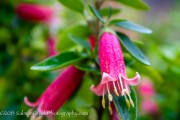
Sprinkled amongst waxy green leaves, ‘Dusky Bells’s pendulous red tubular flowers, dressed in chartreuse calyxes and flared tips, become one of winter’s more endearing attractions. The dainty long lasting blooms appear in autumn and persist through early spring, luring both gardeners and hummingbirds alike.
Whether utilized as a low mounding specimen in a large vessel or as a tidy evergreen ground cover for banks, hillsides or other tough spots, the Red Australian Fuchsia favors good drainage and light shade where it’s hot. This densely branched shrub is undaunted by deer, ocean frontage, poor rocky sites, and occasional drought. Affiliate with other steadfast companions like Ceanothus ‘Concha’ and Stipa arundinacea.
Blooms November – early March.
Size: 18" – 2' 0" high x 2' 0" – 3' 0" wide.
Hardy to zone 9.
Each $14.75
Parented by two Australian species Correa alba and Correa backhousiana, this stylish evergreen hybrid originated in the 1940s at the hands of celebrated San Francisco-based plantsman Victor Reiter Jr. The pendulous, bell-like ivory white blooms showcase 4 dainty flared petals plus sage-green calyxes from late fall through early spring amid small, oval-shaped, short-haired gray-green leaves donning pale felted undersides and fawn-hued stems. An easy-going durable shrub for seaside plantings, water-wise gardens and containers, ‘Ivory Bells’ cheers winter days, nourishes hummingbirds, begs superb drainage, needs only moderate water and appreciates some shade in hot locales.
Blooms November–March
Size: 4' 0" high x 4' 0" wide.
Hardy to zone 8.
Correa reflexa ‘Carpenter Rocks’ (S-0756)
OUT OF PRODUCTION AT THIS TIME
Email me when this plant is available
Bright vermilion nodding narrow blooms with flared chartreuse tips jazz up a tailored dark green foil. Sporting a glint on top and lighter undersides, clasping pairs of small narrowly heart-shaped leaves cloak the rounded, intricately branched habit of this preeminent Australian Fuchsia. Introduced by U.C. Santa Cruz and Koala Blooms, ‘Carpenter Rocks’ makes an attractive textural statement when planted in drifts or sited singularly in a shrubby border.
Blooms November–early March.
Size: 3' 0" – 4' 0" high x 3' 0" – 4' 0" wide.
Hardy to zone 9.
Corylopsis
Winter Hazel
These deciduous natives of Japan and China offer winter charm with their open structure, delicate branching patterns and fragrant pale yellow bells that populate pendent clusters in early spring. Like rows of tiny lanterns, the flowers dress up bare limbs before handsome, rounded hazelnut-like leaves appear. Corylopsis are outstanding when grouped as a backdrop for perennials and grasses, planted in drifts at the edge of a wooded area, or placed under the partial shade of a pine or maple canopy. Provide a sheltered location, decent drainage, acid soil and moderate summer water.
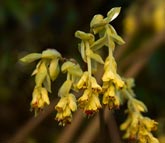
This choice refined shrub will enhance a woodland garden with the scent and sight of soft yellow blooms on pendulous 3 in. racemes. The close-set bristle-toothed leaves, which cloak gently arching branches, are smaller than others in the genus. Long-lasting as a cut flower, Buttercup Winter Hazel is irresistible, especially when early blue-flowering Brunners are planted below.
Blooms March–April
Size: 5' 0" high x 8' 0" wide.
Hardy to zone 6.
Though Winter Hazel’s dangling chains of primrose-yellow flowers are always a much anticipated, late winter delicacy, this new splendid cultivar offers an additional radiant bonus. Butterscotch colors bathe the rounded deciduous foliage, which emerges with red and orange tints, matures quickly to canary-yellow and dons saffron and pumpkin shades for fall. All this lambent splendor embellishes layered, zig-zagging and gracefully arching branches. Championed by hummingbirds and bees, ‘Aurea’ can be situated in a shady open setting, where it sheds light on deep green shrubs and perennial shade aficionados such as Omphalodes, Corydalis or ferns.
Blooms March–April
Size: 6' 0" high x 6' 0" wide.
Hardy to zone 6.
Cotinus
Smoke Bush
Cotinus coggygria ‘Daydream’ (S-0757)
OUT OF PRODUCTION AT THIS TIME
Email me when this plant is available
With prolific and large ultra-fluffy plumes, packed full of shell pink and maroon flowers, winsome bluish green foliage and a compact multistemmed hearty habit, what’s not to love about this daydream? Its over-the-top floriferous display and fiery scarlet autumn encore were first observed more than 50 years ago at Michigan’s Newport Nursery and subsequently patented in 1959. Highly prized by horticulturists and savvy gardeners alike, ‘Daydream’ promises to lull your senses when ensconced near cohorts such as Hydrangea quercifolia ‘Ruby Slippers’ and Panicum ‘Warrior’.
Blooms July–August.
Size: 8' 0" – 10' 0" high x 8' 0" – 10' 0" wide.
Hardy to zone 5.
Cotinus coggygria ‘Young Lady’ (S-0786)
OUT OF PRODUCTION AT THIS TIME
Email me when this plant is available
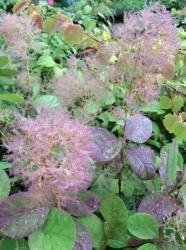
If you’ve lusted after a Cotinus but didn’t feel like you had the room, consider this floriferous smaller statured Smoke Bush. Compact slow growing stems plus rounded glossy green leaves elevate a cream-tinged pink frothy mass of colossal flower pouffes. The astonishing floral presentation unfurls at an earlier age than most Cotinus, while the brilliant orange and red fall foliage vitalizes the late season garden. Developed by Dutch breeder, Hendrik Kolster, easily managed ‘Young Lady’ looks splendid in a good-sized container, ensconced near a bench and anywhere else that is tight on space.
Blooms May–July
Size: 4' 0" – 6' 0" high x 4' 0" – 6' 0" wide.
Hardy to zone 5.
Cotinus ‘Dusky Maiden’ (S-0874)
Each $17.25
Meticulously crafted by British plant breeder Peter Moore over the course of a decade, this interspecific cross between Cotinus szechuanensis and Cotinus coggygria ‘Velvet Cloak’ is a shapely prismatic marvel. Bathed in opulent plum-red hues, the oval wavy-edged deciduous leaves embellish a close-knit well-branched foundation beneath large long-lasting ethereal pouffes of small flowers with lanky rose and wine-colored filaments. Ideal for well-drained mixed borders, fertile woodland peripheries and patio containers, ‘Dusky Maiden’s hearty no-fuss foliar display becomes even more dazzling in a sunny spot, then ends the season blazing a gold, tangerine and scarlet-red fall finale. (pp#20,358)
Blooms June–July
Size: 5' 0" – 8' 0" high x 5' 0" – 8' 0" wide.
Hardy to zone 6.
Cotinus ‘Golden Spirit’ (S-0734)
OUT OF PRODUCTION AT THIS TIME
Email me when this plant is available
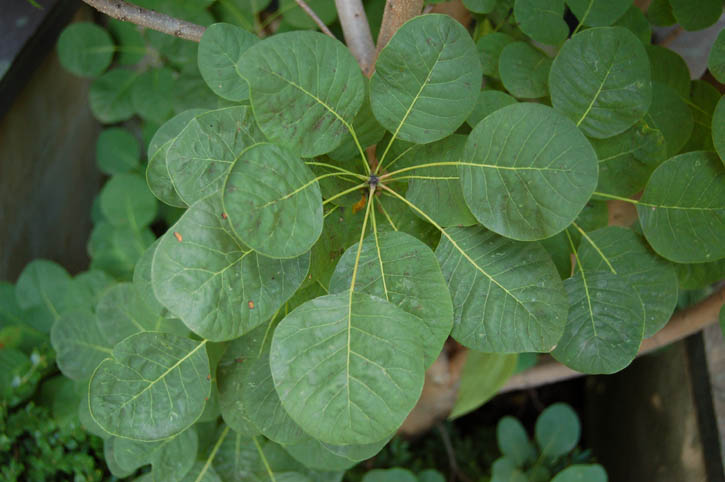
Hallmarked by a lambent-leafed spectacle bridging three seasons and signature gauzy panicles, this new upright Cotinus makes a dynamic mainstay for any garden. Young leaves emerge a lime-green color, turn a brilliant golden hue in summer, and then broadcast a glorious mélange of coral, orange and red in autumn.
An Adriana Sanders-van Harn introduction and a lively companion for blue flowering Clematis, Aconitums and Oakleaf Hydrangeas, ‘Golden Spirit’ develops as an open multistemmed deciduous shrub that appreciates average moisture, some protection from hot scorching sun and a pruning to maintain its size and good form. (pp#13,082)
Blooms July – August.
Size: 8' 0" high x 8' 0" wide.
Hardy to zone 5.
Each $17.25
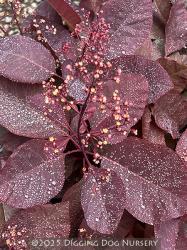
An arresting beacon as the sun casts a ruby glow through its purple-black leaves, ‘Grace’ inherits her elegance from Cotinus coggygria ‘Velvet Cloak’ and Cotinus obovatus. The sprays of tiny deep pink flowers throw a smoky, wine-colored fog over its robust form, and a close glance reveals bright yellow at the center of each bloom. Lovely in contrast with the silver foliage of Teucrium fruticans (Select Form), ‘Grace’ conveys a stately presence matched by few other plants.
Blooms July–August.
Size: 12' 0" high x 12' 0" wide.
Hardy to zone 5.
Cotoneaster
Bearberry
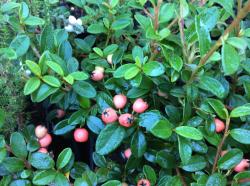
A more compact habit, increased leaf luster and copious coral-red fruit distinguish this winsome AGM recipient from the species C. dammeri, which hails from central and southern China. Boasting easy-care, year-round appeal, the attractive interlacing mass of stiff slender branches premieres diminutive, 5-petaled sparkling white flowers with purple anthers plus colorful late summer and early winter fruit. Petite, leathery deep green mostly evergreen foliage tinges purple in cold weather. Undaunted by deer, poor soil, dry conditions and erosion, but woeful if the weather’s too hot, long-lived ‘Coral Beauty’ crafts a low-lying woody ground cover for rock gardens, foundations, walls or embankments.
Blooms May–June
Size: 6" – 12" high x 4' 0" – 6' 0" wide.
Hardy to zone 5.
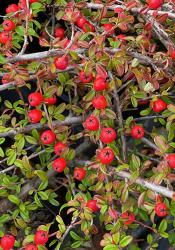
Sparkling star-like white flowers that are larger than those of the central Chinese species, plus tiny bright red berries dress up the round-tipped prominently veined dark green foliage. Growing as a dense polished ground cover, resourceful ‘Mooncreeper’s narrow ground-hugging red-tinged branches are perfect for massing. This winsome evergreen can be added to a bonsai collection, rock garden, foundation planting or embankment, where it abides deer, poor soil and southeastern humidity.
Blooms May
Size: 4" – 5" high x 3' 0" wide.
Hardy to zone 5.
Daphne
Lilac Daphne
OUT OF PRODUCTION AT THIS TIME
Email me when this plant is available
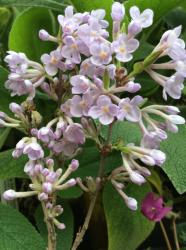
A striking deciduous selection made at the Beijing Botanic Garden by Don Hackenberry, this deer-resistant gem celebrates a lilac-like bounty of delicate tubular-shaped lavender pink blossoms on unique, long leafless sable gray stems. Every node of the wiry upright vigorous growth sprouts a breathtaking flower followed by handsome greenery with silken-haired undersides. Good drainage, acidic nutrient-rich soil and a little shelter from late frost ensures Daphne genkwa’s singular beauty, while a permanent residence guarantees its survival.
Blooms April–early June
Size: 3' 0" high x 3' 0" wide.
Hardy to zone 5.
Daphne x ‘Lawrence Crocker’ (S-0825)
OUT OF PRODUCTION AT THIS TIME
Email me when this plant is available
Named for the co-founder of Oregon’s Siskiyou Rare Plant Nursery and applauded as the best dwarf hybrid Daphne, this pint-sized, sweetly perfumed evergreen is a cross between D. arbuscula and D. collina. Wafting an intoxicating spicy sweetness, clustered deep pink blooms open from purple buds upon narrow, firm, shiny dark green leaves. The dense slow growing mound can be nestled into the rockery, atop a stone wall, along steps or in containers. Favored by butterflies as well as gardeners, but ignored by deer, ‘Lawrence Crocker’s handsome low habit craves summer mulch, protection from harsh winter wind and evenly moist, well-drained niches with a neutral pH.
Blooms May–August
Size: 8" – 12" high x 0" wide.
Hardy to zone 6.
Coveted for its abundance of delectable light purple blooms, this mostly-evergreen chance sport was found growing on an individual Daphne odora ‘Cameo’ plant in Ashhurst, New Zealand. Pointed dark reddish purple buds herald the clustered tubular flowers that waft a heavenly sweet scent infused with carnation, jasmine and hyacinth notes. Garbed by gleaming, elliptic to obovate-shaped bright green foliage, the tailored bushy habit can dress up well-drained small gardens, sunny courtyards, rockeries and patios, where it snubs the deer, but welcomes pollinators, appreciates enriched slightly-acidic soil and begs one more heady whiff.
Blooms March–April
Size: 2' 0" – 3' 0" high x 3' 0" wide.
Hardy to zone 7.
OUT OF PRODUCTION AT THIS TIME
Email me when this plant is available
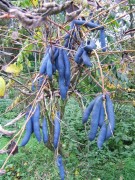
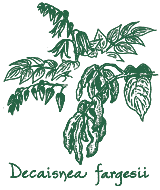
The common name of this fascinating deciduous shrub conjures strange images–and it delivers. Attaining a length of 2 to 3 ft., bold pinnate leaves cloak an airy structure of stout, upright stems in tropical luxuriance. Amid young blue-tinged leaflets, which mature to dark green above and glaucus blue-green below, pendulous yellow-green panicles of dainty star-like blooms set the stage for extraordinary droves of beefy broad, 3 to 4 in. long, slate blue beans. Large decorative buds provide winter allure.
Blue Bean hails from the highlands of western China but is easy to grow anywhere, when planted in a moist well-drained location, it soars.
Blooms May–June
Size: 10' 0" – 18' 0" high x 10' 0" – 18' 0" wide.
Hardy to zone 6.
Deutzia
Closely related to Philadelphus, these deciduous Asian shrubs are named after Johann van der Deutz, a lawyer, town councilor and amateur botanist from Amsterdam. Gracing the garden with a lovely long lasting profusion of flowers, Deutzias are simple to cultivate in any well-drained fertile soil.
Deutzia gracilis ‘Duncan’ (S-0605)
Each $14.75
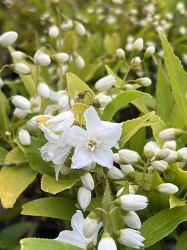
Drink in the pearlescent splendor of this spirited vintage whose frosty star-shaped blossoms sparkle amid burn resistant and serrated lemon-green foliage. Exploding from clustered immaculately white buds, the delicate flowers adorn gently arching branches. A luminous companion for Viburnum ‘Molly Schroeder’s deep greenery, with the small textural leaves of Ajuga ‘Emerald Chip’ skirting below, ‘Chardonnay Pearl’s orderly profile assures a bright crispness all season. (pp16,098)
Blooms late May–early June
Size: 2' 0" – 3' 0" high x 2' 0" – 3' 0" wide.
Hardy to zone 5.
Deutzia gracillis ‘Nikko’ (S-0140)
Each $14.75
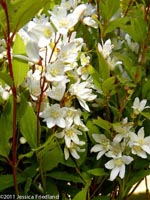
Unfurling from a galaxy of small round buds, dainty five-petaled crisp white blooms illuminate this tailored low growing Japanese cultivar. ‘Nikko’s diminutive dark forest green leaves fashion a compact ground cover-like shrub that entertains wine red shades in autumn and makes a stellar candidate for the rockery, nestling along steps or any other cozy nook.
Blooms March – April.
Size: 2' 0" high x 3' 0" wide.
Hardy to zone 5.
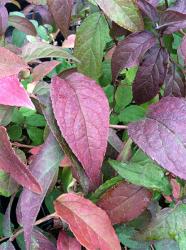
A Deutzia longifolia and Deutzia discolor hybrid, this bushy medium-sized deciduous shrub champions sumptuous, softly scented conical panicles. The bee-friendly, 5-petaled rich rosy-magenta blooms are garnished with creamy-white picotee edges plus pale pink centers amid ovate green foliage and arching stems. Quibble-free, responsive to pruning and grateful for adequately moist, humus-endowed enclaves, ‘Strawberry Fields’ rapidly develops a rounded, upright multistemmed habit, embellishing slopes, foundation plantings, mixed borders or informal hedges.
Blooms May–June
Size: 4' 0" – 5' 0" high x 4' 0" – 5' 0" wide.
Hardy to zone 5.
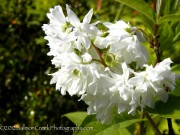
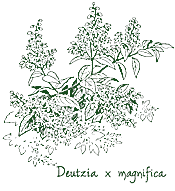
As the name implies, this is a magnificent hybrid that comes to us via the famous Lemoine Nursery in France, where many Deutzia and the closely related Philadelphus were hybridized between 1894 and 1927. It is a vigorous, upright shrub with a dense branching habit. Its exfoliating bark and pure white double flowers, carried in tightly clustered sprays along the branches, create much interest, especially in a shrubby or mixed border with a dark background.
In our garden, we contrast the white flowers with purple-leafed Cotinus ‘Grace’ and summer blooming Hydrangea ‘Blue Billow’.
Blooms June–July.
Size: 6' 0" – 8' 0" high x 6' 0" wide.
Hardy to zone 6.
OUT OF PRODUCTION AT THIS TIME
Email me when this plant is available
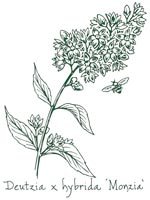
This exuberant bloomer parades dense frothy clusters of striking star-styled flowers, gradating in color from deep to light pink with white at the base and along the margins of each pretty petal. Opposite elliptical green leaves line long gracefully arching stems and older stalks, which sport exfoliating reddish brown bark. A robust easily cultivated hybrid between Deutzia longifolia and Deutzia discolor, ‘Monzia’ is well-suited for a mixed border or an informal hedge, where its deciduous upright visage and amazing floriferous display appreciate good drainage, moderate fertility and an occasional hard pruning.
Blooms May–June
Size: 7' 0" high x 5' 0" wide.
Hardy to zone 5.
Diervilla
Bush Honeysuckle
Named after a French surgeon called Dierville who introduced the plant to Europe in the early 1700s, this small staunch genus counts Honeysuckle and Weigela among its cousins and calls the southeastern U.S. its home.
Diervilla lonicera ‘Copper’ (S-0736)
OUT OF PRODUCTION AT THIS TIME
Email me when this plant is available
‘Copper’s vigorous, low mounding form makes a colorful statement with red-tinted stems, delicate lemon yellow flowers and opposite lance-shaped, deciduous green leaves that transmute copper shades when unfurling and red and purple hues come autumn.
Undeterred by varying soil pH and excessive moisture or drought, the highly enduring Bush Honeysuckle can serve as a honey plant, while underground stolons control erosion. It’s the best choice for dry alkaline sites and looks attractive just about anywhere else.
Blooms June – August.
Size: 4' 0" high x 4' 0" – 5' 0" wide.
Hardy to zone 4.
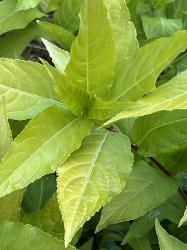
Blessed with a Midas touch and copious nectar, this marvelous golden-hued Diervilla bears loose terminal clusters of 2-lipped tubular yellow blooms that mesmerize bees and butterflies. Masterminded by Dutch nurseryman William de Bruijn, ‘Honeybee’s attractive lance-shaped deciduous leaves promise gleaming accents for containers, mixed borders or along pathways, and chartreuse tones for shady nooks. The compact bushy habit touts a resilient and amenable constitution, appreciating well-drained sites, yet enduring poor soil, cold winters, occasional dry spells and either sun or shade.
Blooms May–June
Size: 3' 0" – 3-1/2' high x 3' 0" – 3-1/2' wide.
Hardy to zone 4.
Diervilla sessilifolia ‘Butterfly’ (S-0787)
OUT OF PRODUCTION AT THIS TIME
Email me when this plant is available
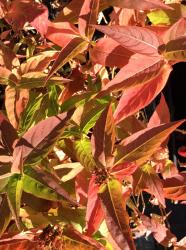
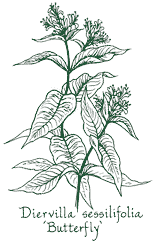
Named after a surgeon called Dierville, this impressive Dutch cultivar is a member of a small deciduous genus that moseys throughout the southeastern U.S. and counts Honeysuckle and Weigela among its kin. A magnet for hummingbirds and butterflies, upright terminal clusters house cheerful yellow flowers with recurved petals and sprightly stamens. The handsome lustrous leaves, characterized by tapered tips, newly unfurled bronze tones and mid-green summer-time hues, signal autumn in shades ranging from ebullient yellows to fiery reds. As if the bounty of sunshine-bright blooms, colorful tidy foliage and sturdy red-tinged stems wasn’t enough, ‘Butterfly’s compact habit exhibits some dogged traits. It can stabilize hillsides plus thwart deer, drought and harsh winds, as well as endure varying sun exposures, poor soil or otherwise difficult sites.
Blooms May–July
Size: 3' 0" – 4' 0" high x 3' 0" – 4' 0" wide.
Hardy to zone 4.
Drimys
Mountain Pepper
Each $14.75
Although the genus epithet is derived from the acrid taste of its bark, everything else about this impeccably tailored shrub is elegant and sweet. Native to Tasmania, Mountain Pepper spawns a striking composition of small lance-shaped lustrous dark greenery juxtaposed against wine-red stems, leaf buds and petioles. The tiny spherical black shiny berries, which follow petite greenish white flowers, plus the smooth thick evergreen foliage with paler undersides, deliver a spicy pepper-like taste savored in Australian cuisine. A swank botanical aristocrat for milder climates, Drimys lanceolata can grace a large container, forge a hedge or stand alone, preferring partial shade as well as rich evenly moist, well-drained soil.
Blooms May–June
Size: 6' 0" – 10' 0" high x 4' 0" – 8' 0" wide.
Hardy to zone 8.
Edgeworthia
Paper Bush
These remarkable Asian Daphne relative promise an unprecedented late winter flower-fest.
Edgeworthia chrysantha ‘Akebono’ (S-0747)
OUT OF PRODUCTION AT THIS TIME
Email me when this plant is available
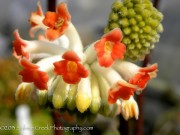
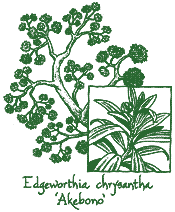
Delivering a late winter visual delight, prominent silky white button-like buds give way to small waxy tubular blooms with luscious tangerine orange shades and a pleasant fragrance. The unique tightset clusters congregate on the tips of erect yet pliable, smooth silver-laced naked branches, which develop in a noteworthy open fashion. Lustrous deep green 4 in. long deciduous leaves arise from the stem apexes. A prized source for high-end paper and a Daphne relation, this Asian native’s slow growing rounded habit enjoys a partially shady somewhat moist sheltered locale, while its exotic flair can be superimposed against a dark backdrop and surrounded by low-lying Epimediums and Sarcococca.
Blooms late-February–March
Size: 5' 0" – 6' 0" high x 4' 0" wide.
Hardy to zone 7.
Edgeworthia chrysantha ‘Nanjing Gold’ (S-0771)
OUT OF PRODUCTION AT THIS TIME
Email me when this plant is available
This remarkable Asian Daphne relative promises an unprecedented flower-fest. Prized for crafting high-end paper, warm brown-colored naked branches—erect, smooth and thick, yet pliable—congregate in a distinctive open fashion with prominent silky white button-like buds at their tips. A late winter bevy of small waxy tubular blooms explodes from unique tight set clusters, delivering a pleasant fresh fragrance and bright gold to creamy yellow shades. Dark green 4 in. long deciduous leaves populate stem apexes. ‘Nanjing Gold’s slow growing rounded form favors a partially shady somewhat moist sheltered locale and injects exotic panache wherever its planted, especially when positioned near broad-leafed shrubs such as Oakleaf Hydrangeas or Physocarpus ‘Coppertina’.
Blooms mid-February–March
Size: 8' 0" high x 6' 0" wide.
Hardy to zone 8.
Aptly named, this topnotch undemanding shrub quickly composes an upright, multistemmed silvery frame well-suited for hedging or screening. The dapper deciduous leaves—long, slender and alternate—manifest tiny bronze dots, which reflect sunlight, and create a splendid sparkle, while small cream-colored flowers tucked into leaf axils exude a sweet fragrance.
Originating in England as a chance hybrid seedling first identified by celebrated British plantsman Roy Lancaster, the ever-acquiescent ‘Quicksilver’ dresses the garden with luminous accents and withstands wind, drought and most soils.
Blooms June.
Size: 8' 0" high x 4' 0" wide.
Hardy to zone 4.
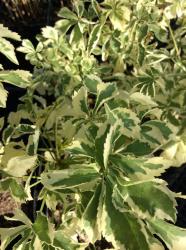
Wherever this carefree East Asian native is staged, it quickly matures into an engaging medium-sized specimen full of panache. Artfully highlighted by irregular creamy-white margins, Buckeye-style, 5-fingered bright green leaves, each with tiny spines at the base, garb numerous upright and arching cane-like stems. This hardy, rounded deciduous shrub exhibits great fortitude and readily adapts to a wide range of soil, even dry conditions, while flourishing in sun or dappled light. The only dilemma you’ll encounter is narrowing down the myriad choices of where to plant Variegated Five-Leaf Aralia: the shade garden, the backside of a perennial bed or mixed border or perhaps along the edge of your property as a screen or hedgerow.
Size: 6' 0" – 7' 0" high x 6' 0" – 7' 0" wide.
Hardy to zone 5.
Enkianthus campanulatus (S-0038)
OUT OF PRODUCTION AT THIS TIME
Email me when this plant is available

The Chinese call the blossoms of this shrub Tsiau-Tsung-hoa or Suspended Bells. Botanically speaking, the true flowers are enclosed in an assemblage of clustered bracts, for a flower-within-a-flower appearance. Borne in clusters, each petal of these ivory green blooms is lightly veined with pink and ends in a delicately scalloped deep pink tip. The glossy, jade-colored foliage provides brilliant fall color. Enkianthus campanulatus is an elegant specimen to star in the shrubby border.
Blooms May
Size: 10' 0" – 16' 0" high x 4' 0" wide.
Hardy to zone 4.
Enchanting creamy yellow blooms—pendulous, distinctively rimmed in deep red and coveted by flower arrangers—earn this outstanding Japanese shrub its cultivar name. More compact than the species, ‘Red Bell’s upright tiered habit generates refined, glistening deciduous leaves, which are clustered at the tip of each twig, transmuting brilliant yellow and fiery scarlet hues in autumn. An elegant specimen for a shrubby border or patio, it relishes adequately moist acidic soil and can be underplanted with Dicentra ‘Bacchanal’ and Asarum splendens.
Blooms May–June
Size: 8' 0" high x 4' 0" – 6' 0" wide.
Hardy to zone 4.
Enchanting large creamy-pink blooms—pendulous, distinctively streaked in deep red and coveted by bees as well as flower arrangers—earn this superior cultivar its namesake. Slightly more narrow than other Enkianthus, ‘Showy Lantern’s upright densely branched habit generates refined glistening deciduous leaves, which are clustered at the tip of each twig, beaming brilliant yellow and fiery-scarlet hues in autumn. An easy-to-grow elegant specimen for a shrubby border or patio, it relishes adequately moist acidic soil and can be planted with Dicentra ‘Aurora’, Sarcococca or Epimedium.
Blooms May–June
Size: 6' 0" – 8' 0" high x 4' 0" – 6' 0" wide.
Hardy to zone 5.
Escallonia laevis ‘Gold Brian’ (S-0759)
Each $12.25
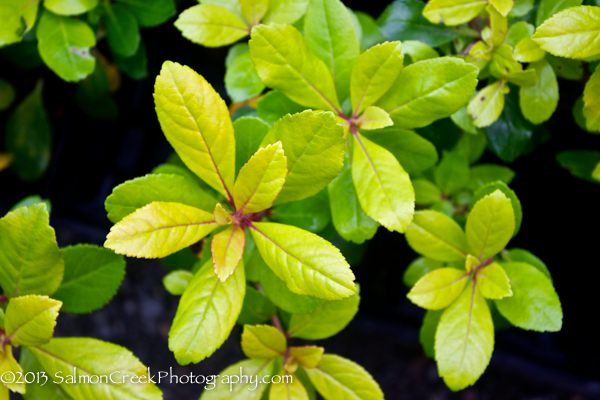
Spangled with incandescent, gleaming golden foliage and terminal panicles of long blooming raspberry-colored flowers, this drop-dead gorgeous evergreen shrub promises to delight you throughout the seasons. The dashing medium-sized rounded leaves are leathery and toothed, transmuting fresh lime-green shades during the summer.
Acquiescent to salt spray and varied soil conditions, even dry ones, ‘Gold Brian’s bushy hard-to-miss visage demands a well-drained abode, a trim immediately after the blossoms are spent and protection from hot afternoon sun.
Blooms July–August.
Size: 5' 0" – 8' 0" high x 4' 0" – 8' 0" wide.
Zone 7/8.
Euonymus fortunei ‘Wolong Ghost’ (S-0803)
Each $14.25
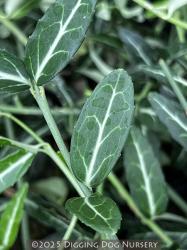
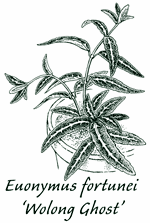
Slim elongated dark green foliage, exquisitely enhanced with silver veins plus a lustrous finish, is the trademark of this stylish hard-to-find ground cover. Selected by Dan Hinkley in China’s Wolong Nature Preserve, Silver-Veined Wintercreeper’s versatile close-knit persona brings year-round non-invasive evergreen accents that augment the rockery, a stone wall or a container, staying low or even clambering upwards, when trained. Undemanding ‘Wolong Ghost’ cherishes quick draining soil and withstands seaside locations as well as deer.
Size: 8" – 12" high x 3' 0" – 4' 0" wide.
Hardy to zone 5.
Fothergilla
Witchalder
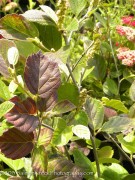
Originating in the Southeast, the genus epithet pays homage to a British physician who specialized in growing American plants. Selected by Mike Dirr, this outstanding AGM recipient features an abundance of fragrant bottlebrush-style creamy-white flowers, borne in large terminal clusters amidst handsome and heavily textured, deciduous deep green leaves with whitish undersides. Possibly a hybrid between Fothergilla gardenii and Fothergilla major, ‘Mount Airy’s vigorous rounded bearing consistently struts spectacular red, orange and yellow autumn color.
Blooms April–May
Size: 5' 0" – 6' 0" high x 5' 0" – 6' 0" wide.
Hardy to zone 5.











